#I’d like to rework this at some point if i get better at structuring. I’m not satisfied by the level of clarity
Explore tagged Tumblr posts
Text
Falin who cares too much and too little - analysis
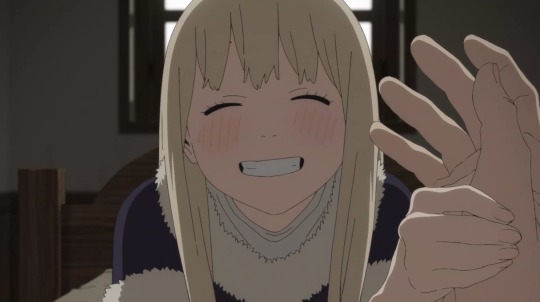
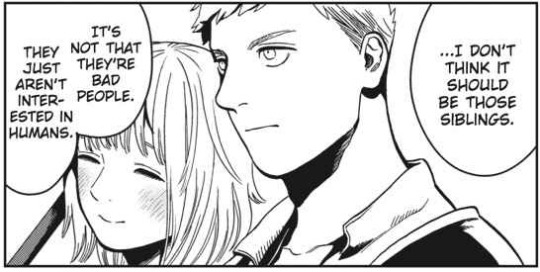
Been stewing on Falin thoughts for a while, I know I have an interpetation on her that differs from many but I’m jumping into the fray. I think there’s a lot to be said about what we do see of Falin. This shorter Falin analysis I made is heavily encouraged prior reading. This analysis mainly explores her complex relationship with caring and so it’s sort of structured in two halves, with Faligon at the crux of it all.
Falin cares too little :
A lot of people assign Falin a people pleasing mindset and I… Don’t agree. We never see her care at all about people in her town or at the academy not liking her.
We do see her worrying about what people think of her… ONCE. And Laios comforted her, told her they didn’t matter and she should be proud of herself. She latched onto that hard. That’s why this scene was so important to be included during the dragon fight, relationship-defining; it’s always been them against the world. She grew to not care what others thought, to only focus on her close loved ones. No one else matters.

Laios’ words were her world. Her older brother who taught her how to feel comfortable with herself, who told her, you’re great, others are the ones in the wrong to not see that, I’ll always be with you, always be there for you. Older brother who always made great plans, who always knew more, who was better at wrestling to name the dogs, who she has always idolized. Laios who always spoke of traveling the world, to which she always said she wanted to follow. And she would, she’d follow him even if it meant leaving the academy and all she knew behind, she’d follow him to the ends of the world, and that’s what she did.
She didn’t care about showing to her classes or keeping up such appearances, she doesn’t even think of toning down her jumping into bushes when Marcille recoils, etc. She acts like an obedient pawn often, to her parent’s directives and then following Laios around no matter what he decides to do, but I don’t think the motivation is people pleasing, rather it’s being with & caring for her loved ones, and her go-with-the-flow attitude enhances the impression. Not that it’s as simple as that, mind you, but let’s talk about this for now.
Falin is perceived as selfless because we, the audience, have our perspectives revolving around the main people in her life (Laios, Marcille). They’re the ones she’s devoted to and people who care about her back a lot too, but to people like her classmates or the towspeople she probably must have seemed like someone who didn’t care about the people around her or her surroundings a lot, who just went on alone and did her own thing.
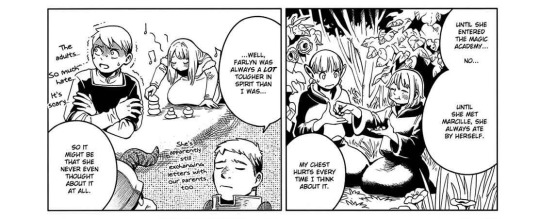
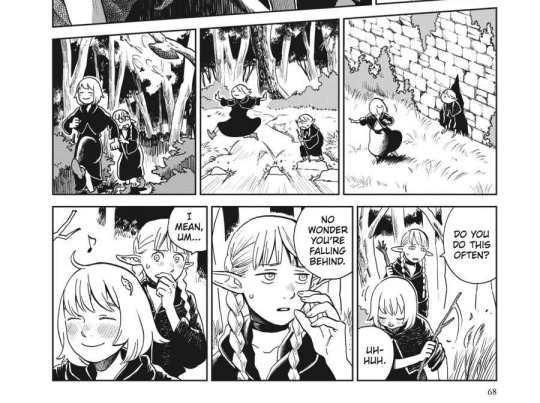
What matters to Falin? From what place does her kindness come from? Is a part of her keeping up appearances? And I think that’s the point, the horror of Faligon as well, that we can’t tell just how in control Falin the person is as the chimera (because we are shown that she’s in there, we just don’t know at what degree), that we don’t know her enough to be able to tell when she’s at her most genuine, her most raw. That even if you do settle on none of her being present as Faligon, we have to at least consider it, consider that she may be able to do something like this and have a part in it, brutal and uncaring. That even the lenses we see her through, the people who love her, may be unreliable.
And this is what’s very interesting about her too, she truly is so idealized by people around her as a saint. She’s so good and kind and caring to everyone etc etc etc. Laios, Toshiro and Marcille all see her as the paragon of goodness in the world. More cynical characters like Namari and Chilchuck have more layered opinions on her, the latter finding her somewhat unnerving because he can’t read her well. But then with that one flashback scene we see that… Her priorities are intensely focused on Laios and Marcille, she doesn’t care all that deeply about anyone other than them (+ maybe her parents). The rest of the party is in the same danger here but only Laios and Marcille who she’s speaking to get the special ,ention, and if they don’t cross her mind then of course she’d be ready to sacrifice strangers through a risky teleportation. That doesn’t make her not kind or caring!! Just that greater good isn’t exactly her priority. Any means is alright if the end result is her loved ones safe, it usually takes the form of healing and caring, but we see she’s ready to fight and make dangerous calls too. To me there’s this aspect to her that she isn’t as pure and magnanimous as everyone thinks she is, both in-world and interestingly enough meta wise as well, and there’s something interesting to that.
People pleasing implies a need to be liked, needs for the motivation to be that. A yes-man, etc. But if we analyze Falin, her general kind, smiling demeanor is more a matter of passivity I yhonk. Conflict avoidance is easier, so she’s friendly and hopefully things’ll be smooth sailing. It’s easy to be kind to classmates even if they act wary and rude if you don’t care about what they think either way. Of course she prefers good things happening to people over bad things, she is genuinely kind, but I think people tend to assign her a very grand altruistic way of life when to her the motivation is pretty self-centered. She doesn’t do what she does because she loves them, but because she loves them.

One situation that’s interesting to dig into for her way of thinking, and what I’m trying to get at, is Shuro’s proposal to her. I’ve seen people saying she hesitated because she didn’t feel comfortable saying no even though she wanted to, "I can’t say no, I don’t want to hurt him", something that sounds sensible and familiar, but it’s actually canon in the Adventurer’s Bible that the reverse was the case, that she didn’t feel comfortable saying yes. Because the offer was tempting, but it’d have been a loveless agreement on her end. And it makes sense she’d want to say yes too, like we see with the Toudens, marriage is very much a political strategical economical thing in their village, there’s even a bit on it on Laios’ Adventurer’s Bible profile about dowries, and both siblings were engaged very early. They lived poorly for a long time, it’s an enticing idea to marry rich, to have not only yours but your brother’s needs met forevermore easily, which at one point in their careers was their main worry and goal. Why shouldn’t she accept a life of leisure and wealth handed to her by a lovely friend?
So her hesitance was "yeah that’s convenient for me, but where it’s everything to him and heartfelt I’m able to be detached because I don’t care about it that much… Can I do that? I’m not reciprocating, not saying yes in the way that matters. Can I do that to him?" Very caring even though it’s not what you’d expect, isn’t it?
And central to my analysis, where I’m going with this is, I feel like that’s the thing with her character, that she doesn’t feel as strongly as she "should" sometimes, or feels a different way than she "should", or at least that she feels that way and others say she does. She didn’t mind suddenly leaving the academy, leaving Marcille behind and not seeing her for 4 years. She acted like it was no big deal that she sacrificed herself after getting resurrected after the red dragon fight. And in both those cases it upset the people around her greatly that she didn’t seem to get why it was such a big deal, didn’t seem to care about how they’d experienced her choices.
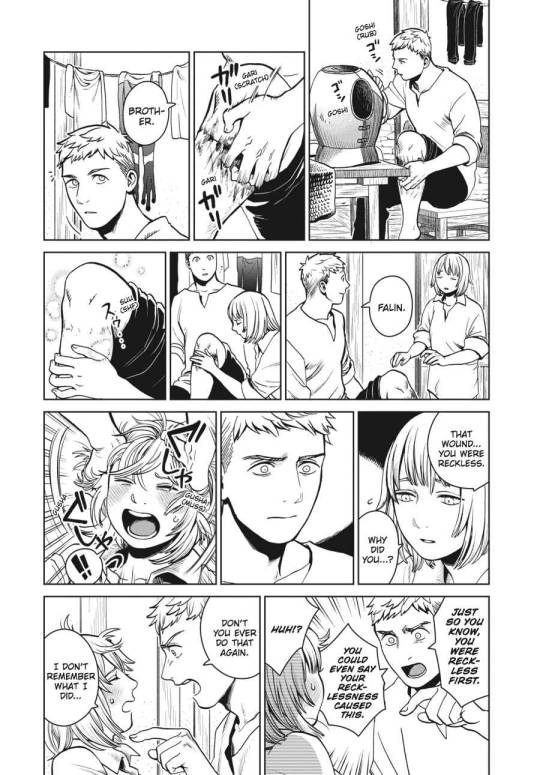
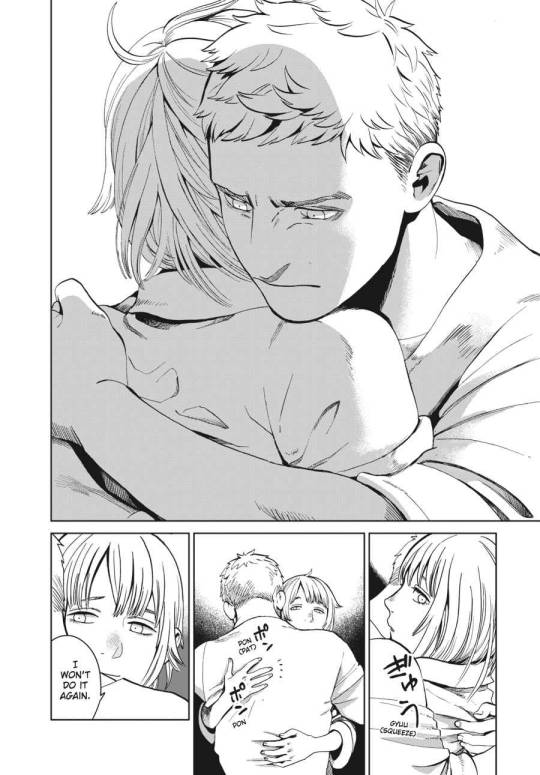
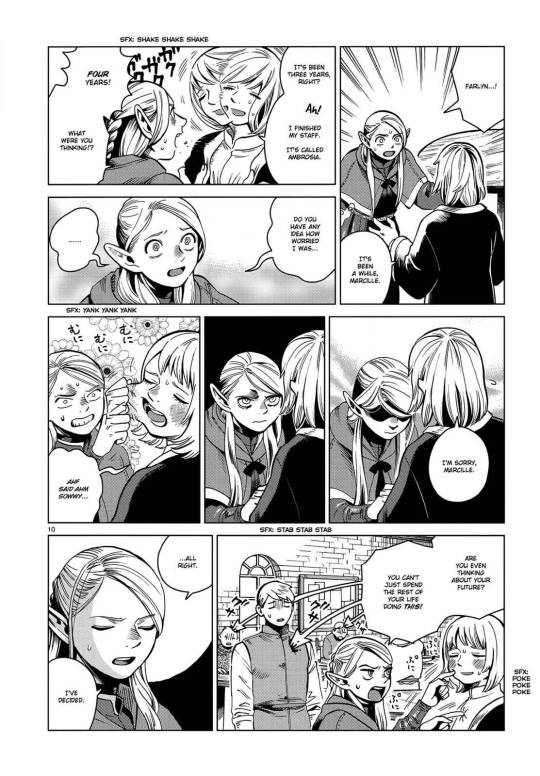
So it’s a tendency… And it’s not that she doesn’t care, it’s just that the way she measures what’s good for the ones she loves isn’t the same as what they themselves think it is (like Laios and Marcille not wanting to be apart from her). It’s an overt but quiet kind of care, it’s doing things like following them around and making sure they bathe and have a meal, even if that means she has to be dragged into misery too.
So yes she probably would know "not caring enough/the right way" is one of her perceived flaws, and that informs how she tries to handle her response to Shuro’s proposal. Her not wanting to accept like her first gut instinct, is because she’s thinking about reciprocity, about if it’d be right to go into this knowing that they have different priorities and she might not be able to keep up with the type and amount of emotions he wants/expects from her. And that’s a big part of her character isn’t it, having expectations pushed onto her. Her trying her best, but in her own way that may seem odd or even unfeeling. Not unlike when she exorcised the ghost as a kid too, unblinking and matter-of-factly, and not seeming to understand why people stared the way they did.
Even though she answered his proposal only post-canon, she’d been pondering it for a while even pre-canon and the Adventurer’s Bible explanation was released midstory, so I’m hesitant to assign her much growth about her hesitation and what I went on above, since she still didn’t react "right" with Laios after the red dragon fight (even if she apparently doesn’t remember sacrificing herself) and put herself in that situation in the first place. She hasn’t finished her arc on that flaw of hers is what I’m saying, she for sure still has it, but I certainly think her thoughts on Shuro’s proposal shows awareness, both of herself and social.
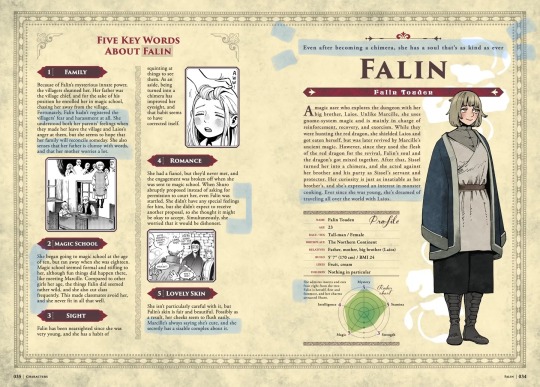
And awareness is a big analysis key word with Falin, especially here it can be hard not to conflate not caring with not knowing. How socially aware is she? It’s rather layered, because canonically she wasn’t aware of her ostracization in her hometown at all, and we’re not sure if she knew Shuro was interested in her before he proposed, but she generally seems more socially aware than Laios. She tags along on his caravan job to make sure he isn’t being mistreated (though doesn’t ask he get a salary), she catches social faux-pas more easily like in the genderbend magic mirror omake with Shuro, and interestingly enough she’s very good at empathizing with her parents and understanding their perspective. We see when she’s worried about Marcille coming that she does know about propriety and how appearances shape impressions. Being a chief’s daughter must at least have taught her a thing or two on that front.
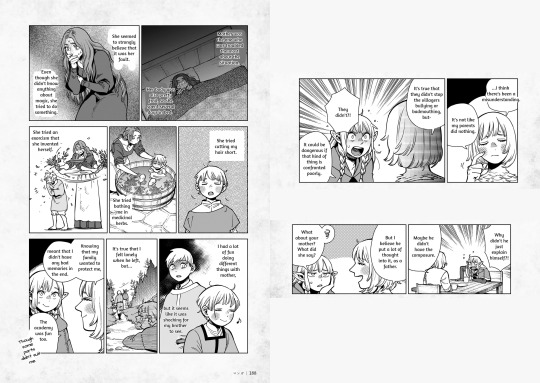
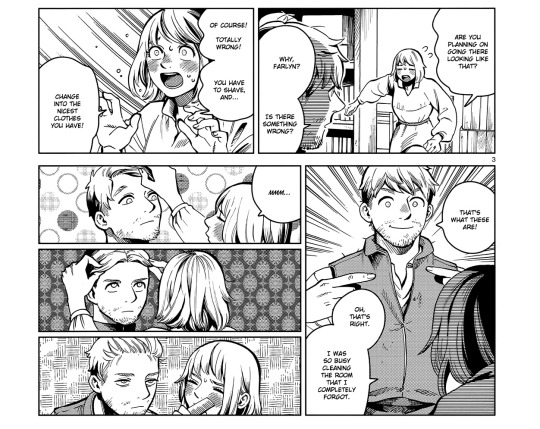
She never stands up for herself, but when it comes to defending others she worries, strategizes and explains.
And this sort of understanding is part of why I think she’d notice the expectations pushed onto her like I was saying earlier, notice how she makes people feel when she’s careless. But if she changes anything about herself in response to noticing is for her to choose, and generally I think it’s a sort of inbetween of yes and no: that she becomes more complacent but also more reserved, complying but by hiding more of herself passively. She’s not sure wether to accept or reject Shuro’s proposal, doesn’t want to lead him on? She’ll just be taking a while to silently consider it, try to keep things as they are for the time being. The third, less conflicting option. She doesn’t feel heard by Marcille who keeps infantilizing her? Just bear with it. Retract yourself emotionally. Settle for it.
We see that when she was young she had a tendency to not read a room, and I think that’s here too. She doesn’t get why her nonchalance upset others but that doesn’t change that she doesn’t want them upset or hurt, so she tries, albeit in maybe a roundabout way. She always had a hard time deeply connecting with people, often keeping herself some amount of emotionally distant: erasing herself from the equation, from the two-way trade that relationships are and making it a onesided thing instead, where all their needs and emotions are directed towards her but she only lets out a bit of her own show. She takes everything upon her and deals with it and tries not to give others this same burden, though not on a conscious level, it’s just that she’s learned growing up that she doesn’t have much agency.
Like I went into with my analysis linked at the beginning, I think Falin is used to just taking what she can get and not asking for more, when it comes to social bonds. She’ll take spending time with her mother no matter what it is they do, she’ll follow Laios to the graveyards and stick by him even when he’s pushing her away (because he doesn’t want her borrowing his book or "No copying!" or such). Her father was always distant, cold and uncommunicative, her mother was considered sick from anxiety and the exorcism attempts were the main way they spent time together, at dinner tables there were only her and Laios. The dogs picked on her too even if she loved them— And so did the townspeople, maybe that being normal to her at home is why she didn’t notice the ostracization she suffered.
She’s always been the last to be asked about decisions or what she wants, never asked to play with at recess, neither her father or Laios asked before sending her to the academy or leaving the village. At home, in the hierarchy she was considered to be below the dogs by the dogs themselves, as someone they can disrespect. Dogs learn from example and behavior, so this means Falin must have been pushed around a lot, and that the family didn’t try hard to rectify the dogs’ misconception, likely worsened by Laios regularly wrestling with her as a competition.
So for example when Falin showed Marcille food, it was her way to implicitly ask to have lunch with her without voicing that question, without daring to take up space. Someone’s presence isn’t something you ask for, it’s something that’s bestowed upon you, you can follow them around but you can’t ask them to stay or to come with.

She’s used to her needs and wants not being listened to, so she’s learned to have less wants. Caring less about herself, caring less about other people beyond her safe zone, was a defense mechanism in part. She has a sense of learned helplessness too, like how when Marcille came to take her away from Laios, even though she didn’t want to leave with Marcille it felt so determined and unshakable to her that whatever Marcille decided Falin would have to comply with.
And still, it’s the "marrying you would be awfully convenient if it wasn’t that I’d feel guilty for not loving you back, the way you wanted me to when you proposed to me" and the "I don’t regret leaving the academy and leaving you behind without goodbyes but I’m sorry that you’re so much more upset about it than me". It’s the guilt of not loving people back the way they want to be, with the same intensity or fervor.
It’s the autism it’s the aroace of it all, it’s the emotional stunting and confusion but the pit in your stomach telling you you did something wrong again. The no object permanence even for people you love even for 4 years, it’s the feeling like you’re somehow at fault for someone having fallen for you and not knowing what to do with any of it. I’m not joking btw it isn’t uncommon for autistic people to not see their close friends for a long while, not having missed them all that much and for that to be really hurtful for the other if they notice/ask about it. "Hiii bestie! Oh umm you’re uh more emotional about this than I expected, hopefully you won’t feel alienated by me not feeling as intensely about it…"
So… Yeah. I think she thinks of things and relationships in a different way than most people, and beyond "good things happening to people is good" I don’t think she actually cares about people all that much. I’d argue that Laios shows more desire to connect with others and make relationships. And just like with Laios and his own issues with humans, that doesn’t mean her kindness is a lie or ungenuine or worthless! It just means that like, well it’s pretty straightforward really, she’s not all that social and doesn’t see casual bonds as meaning all that much and whatnot. She does want to see people happy, but it’s not as much like… A conviction or goal. She’s too laser focused on a select few people. "It’s not that they’re bad people, they just aren’t interested in humans."
And sometimes it feels like people get defensive about Falin in a meta way too, like if you ever so much as imply Marcille isn’t her whole world or that she isn’t the kindest soul out there then you’re saying she doesn’t care at all or she’s evil. And that’s actualy exactly the sort of vibe I wanted to get through with my analysis above here actually haha, that she does care and she is kind but it’s not in a way that’s quantified or understood in a way that makes people feel comfortable. In a way, that makes people feel insecure because they don’t have the same logic as her, don’t show love the same. And I think this is another stellar depiction of autism, of parts of it that feels unpalatable to many, if I’m making sense. The fandom idealizes her as well, which isn’t uncommon or surprising for the character embodying the trope of the perfect beloved to rescue.
And disclaimer, as I said in the tags I feel like the details of Falin are pretty vibe based when it comes to analysis, there’s absolutely a valid angle where she does super care about everyone always, feel free to disagree with me on the overarching angle of my analysis. There’s enough supporting evidence to tip the balance either way I think, and the reason I’ve chosen this angle is I feel it’s more compelling for the themes in Dunmeshi of idealization and being different, of desires vs wants, and because I think it neatly ties up Falin’s character arc as I’ll go over throughout the next section…
So.
Not feeling as much as she should. And……. Is this not Faligon pushed to the max?
You can’t tie down a dragon. As the chimera, she gets to just not care about everyone else and be on her merry way.
Part of it I think is finding comfort and freedom in the mindlessness, in not having the burden of feelings and connections and a consciousness (despite still ending up seeking those in a stranger, Thistle). Like when she’s dead in the purgatory as well, she gets to just… Hang around and do whatever. Similarly to when she played in the forest instead of going to class in her academy days. That’s what freedom and peace of mind looks like to her. Why she decides to roam post-canon, if only now with the goal to find herself instead, with her mind in tow and somewhere to go back home to.
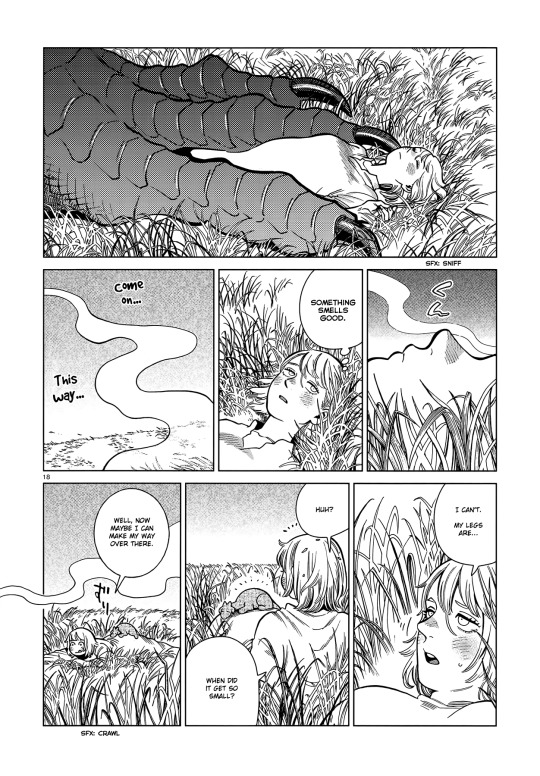
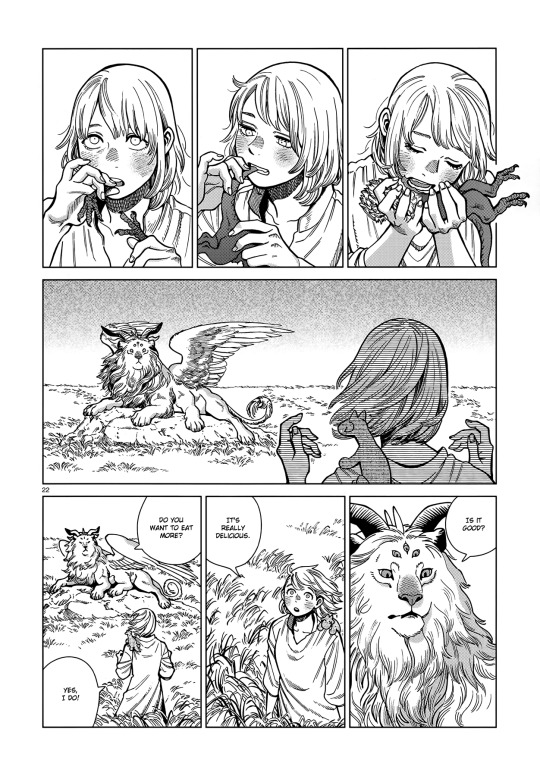
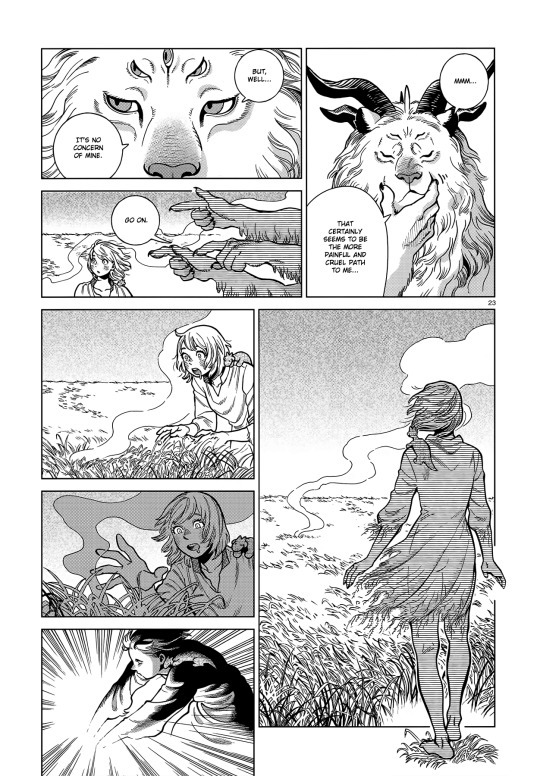
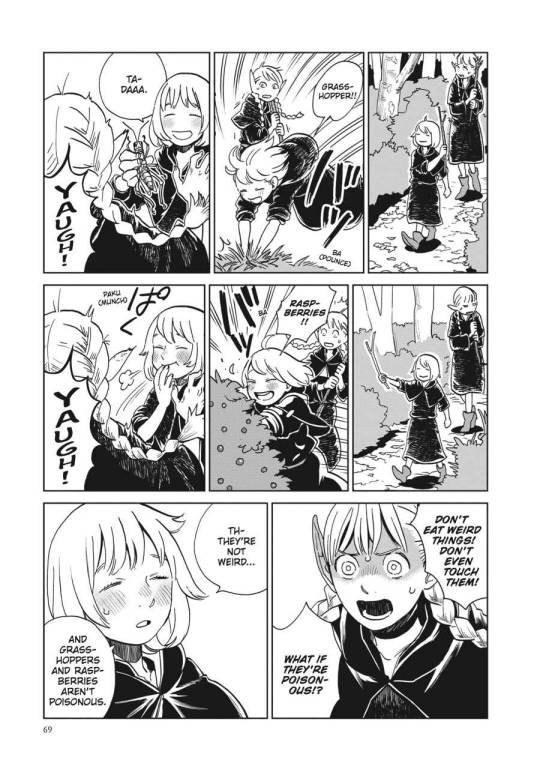
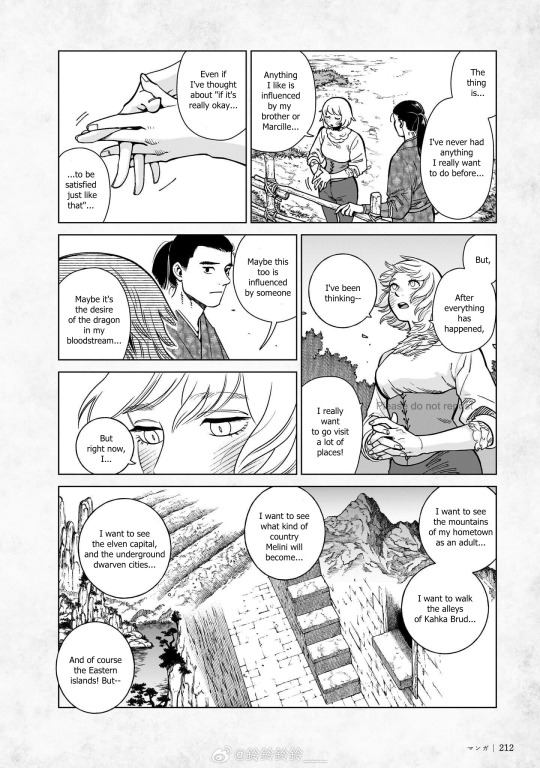
There’s excellent analytic framing out there about how of course, Dungeon Meshi has a big theme of grief and letting go, and… Falin was always a symbol narratively, idealized by characters and often underconsidered by them despite their love. It was Falin’s choice to sacrifice herself for Laios, she thought it was worth it, knowing that it would be her end. Her resurrection and the process of it intertwining her soul with a dragon’s wasn’t done with her consent, and the subsequent opening it gave her to become a chimera puppet. She’s stripped of her agency consistently, and so… It’s very noteworthy that the final choice, of wether to go back to life or to stay dead, in that purgatory scene, was up to her. And she chooses life, but I do think about her in those fields and how at home she seemed there. Peaceful, by herself in a vast calm expanse she could explore, free.
Personally, I think freedom is Falin’s own subconscious selfish desire. And though to us becoming the chimera is obviously a shackle, I think it felt like freedom to her somewhat, too.
And if you think I’m going wildly off the rails here I want to talk about Laios’ wish of becoming a monster. And to be clear before getting into it, being mentally a monster is absolutely a big part of the appeal for Laios, it’s something that’s consistently referred to, something especially pointed out in the werewolf monster tidbit with Lycion. Right panel is from that, but left panel is from the extra with Izutsumi where Lycion talks about suppressing souls in a beastkin body, the human or the beast soul.
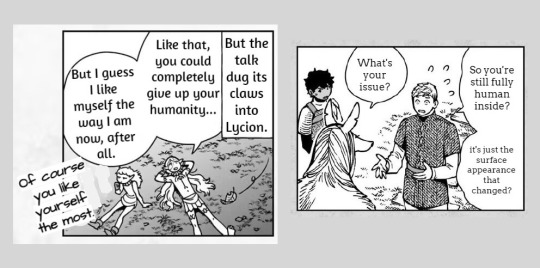
Finding comfort and freedom in being mindless, less sentient, less aware? While being unaware in her hometown might have saved Falin a lot of heartache although perhaps stunted her emotional growth, it’s always been Laios’ curse.
Actively, through his choices, he seeks to grow closer to people, to form deeper bonds, to understand and be undertood, but… On a deep seated level, what he desires is to leave humanity and civilization behind. He has an irrational hatred for humans, born from the trauma of ostracization, being different, being beaten up and rejected consistently through his life. Running away from problems is easier. He wants to be free from being a social animal from a social species who has deemed him the black sheep, he thinks it’d be simpler to just leave it all behind, people and his own humanity. At its core, to Laios becoming a monster is a power fantasy, a coping daydream of "if only I could be strong enough to never be hurt again, the power to destroy anything I want, the power to go somewhere better, if only it was possible for me to never feel hurt again. If only I could be someone, something, that can never be hurt". "If there’s someone you don’t like, you can gobble ‘em up in one bite. If you could fly, you’d be able to leave this village right now." It’s a childhood fantasy, from a deep sense of being misplaced and a desire to be able to stand fearless, thinly covering up resentment that Laios represses.
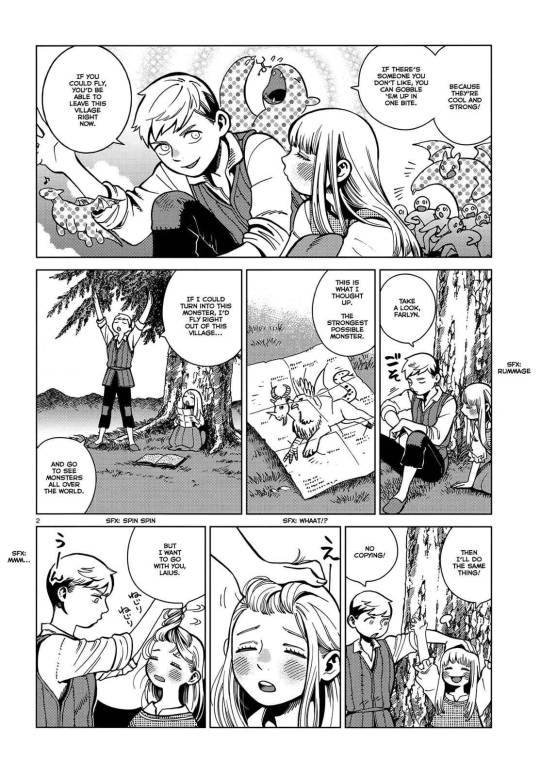
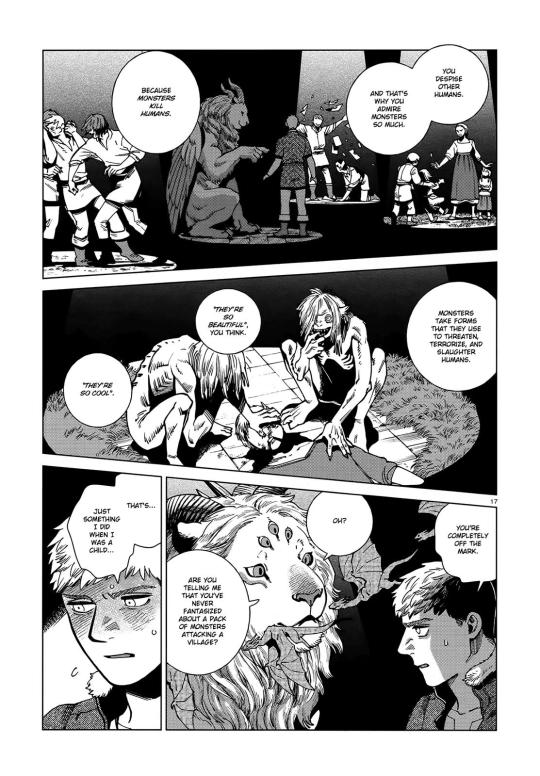

But you’ll notice, when the Winged Lion is enticing him in the last page, even now with his lifelong wish of becoming a monster on a silver plate, he still cares about his friends. He still has that sense of responsibility to his friends, doesn’t want to leave knowing they’ll be in danger and alone. The offer that his friends may be left unharmed is already good, but Laios also visibly flinches when the Winged Lion offers to specifically care after Marcille and rid her of her biggest fear. Laios’ care runs that deep. Not unlike with the succubus, he resists temptation until he gets reassured that everyone will be okay. But see, what he desires isn’t to stand alongside Marcille until her last days, it isn’t to stay and see how well his friends will live, it’s to go. It’s to leave. It’s to fly away, a monster both in body and mind. He wants to be free from caring here, wants to not have to worry about his friends, wants to just go do his own thing, but for that he needs to feel safe in the belief that said friends will be safe even without him being there to see it, because despite everything else he cares, he does. It’s again that dichotomy about caring and wishing you didn’t, or not caring and wishing you did.
In the end, it’s Falin who achieves that wish. Both by becoming a chimera during canon, and by going traveling post-canon. In the latter, being both free of human relationships as something chaining you while still being uplifted by them, by the knowledge that there are people out there you love and that love you. It’s a theme that can also be connected with Marcille, because she gets anxious over people she loves getting out of her sight, worrying they’ll get themselves killed, that time is passing while they’re away from her. But before she can get to the point where she can both have her freedom and being uplifted by her social bonds, regaining both her individuality and her connections, she has to get a taste of just one at a time. Before they can find balance in her life, she has to see what it’s like to have what she’s never had on its own. Unapologetic freedom, and power.
No one can blame you for not caring enough or caring right if you’re a fricking dragon!!!! You make the rules when you’re a beast and you can just… Fly away. From anywhere, from anything. And if a dog bites you you can just crush it. Instead of being pushed around by the dogs because you’re at the bottom of the hierarchy, you’re now at the top, the one with the power to be heard and do what you want without consequences.
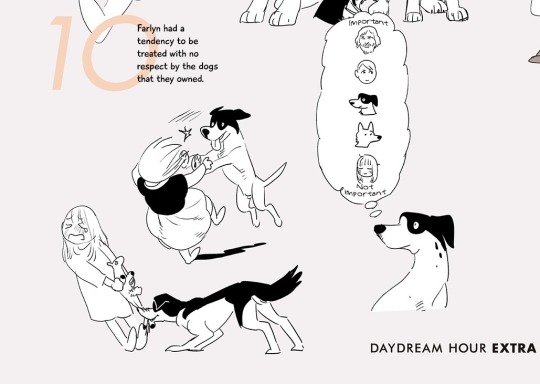
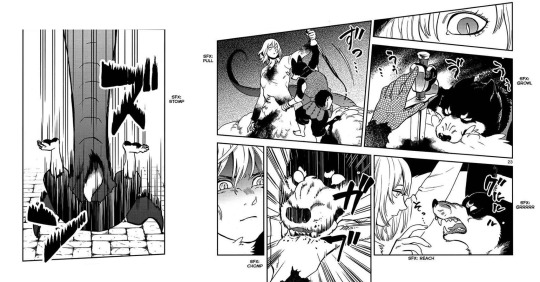
I think she’s on autopilot. I think she’s on autopilot a lot of the time, even before being a chimera, and it’s partly why her will is so weak compared to regular dragons. (Again, read my shorter analysis.) It’s familiar to slip back into the role of following someone around unquestioningly. And that’s what is weaponized when she’s a chimera, that instinct she’s been nursing all her life to unconditionally support, defend and follow someone. Only now, that someone doesn’t matter in itself, only the symbol of it. She doesn’t mind, either way is fine. Her will is weak after all, because she’s trained it to take as little place as it could.
Falin cares too much
She spends all her time caring for Laios and Marcille alternating that none of her care and emotional energy is left for others, including herself. So she had to get relieved of all of that for a bit, becoming the chimera so she could reset and recenter and remember that she, too, indeed, is there and an important part of her own life.
So you’re probably seeing the duality I’m talking about here, Falin is very self-sacrificial but for specific people in ways that they often don’t recognize or appreciate. She cares but selectively, both in people, putting all her eggs in the same baskets, and in the ways she cares after them. She doesn’t care a lot, but when she does she cares a lot. Falin doesn't have a lot of earthly attachments, but when she does, they're her world.
In canon her arc, especially post-canon, is to grow beyond Marcille and Laios. Her caring for her close loved ones held her back from looking after her own self-fulfillment needs. And this is what I mean when I say she cares too much; she could gain from caring more about the world besides Laios and Marcille, both lands wise and people wise. She cares too little, but her arc centers her flaw around caring too much instead. Her pitfalls that Kui highlight over the course of the story, while of course her selflessness is appreciated for how she saved Laios and everyone, on a personal level is shown to be self-effacing and damaging. She’s undermined by Marcille, without the courage to voice her thoughts and wants, she would dedicate her whole life to Laios. And I mean, it’s text, in the response to Shuro’s proposal extra no less. And she’s so laser focused on her most loved people that she’s fine with being callous and risking others’ lives, even.
Post-canon, she needs to leave to find herself, away from them.

Herself. What if she wants to just be with herself for a while.
And this is me reaching but I feel like, not unlike Izutsumi who learns to feel this sense of never being alone, always having someone on your side what with having two souls, the dragon in her would make her consider herself more. She finds it easier to care after other people after all, and in the purgatory fields sequence she takes care to bring the bit of dragon left with her… Not unlike with Izutsumi, having two souls forces you to think about your identity and figure yourself out. Besides being this sort of duo now, where if she wants to care after herself she can channel it to that other side of her too… In meta dragons are symbols of greed, and I think the bit of dragon would push her to want more and listen more to her desires, primal and self-serving as they might be. The dragon soul which warped her human body with feathers and draconic features, her image of perfection marred, her weirdness externalized in a way that’s not palatable. But she doesn’t care, about if her appearance is palatable for most people, she hasn’t for a while now, and that’s great.
Notes & nuance
I’m struggling with the structure of this post, making my points organized, concise and strong at once. It’s difficult to make any statement without going "things are generally like this, but there’s this time that this contradicting thing happened too" or "it’s ambiguous enough that you should just follow my interpretation for the time of this analysis" haha, so this is the pit where I put all the stuff that wouldn’t fit well in other places but are interesting for Falin’s character. This section is pretty separate from the main thesis of the post, it’s just more Falin observations. The post has reached the 30 pics limit so I can’t just pull it up whenever it’s relevant but I really encourage scrolling up to read the stuff I highlighted in her Adventurer’s Bible profile if you haven’t already.
I think with the shy-looking loner type autistic kid archetype, and knowing she didn’t seem to mind others ostracizing her, it’s easy to lose sight of how she was by no means an unemotional child. In all the bits we see of her as a kid she’s bursting with energy and emotions. Canon confirms Laios leaving the village did affect her and make her lonely and she cried a lot, too. She may not be social in the traditional sense, but she was clingy with her brother, and she also never was all that shy about who she was, wearing her heart on her sleeve.And okay. Okay okay okay. Speaking of appearances. About what I said of her not caring about what people think of her, even seeming defiant with the caravan leader… There’s one istanxe of her caring actually, and it’s about how her face blushes easily. I remembered it as being because Laios’ said it and as I rambled Laios’ words are her world, but actually it’s ambiguous. It’s only Marcille imagining up this scenario where Laios says Falin looks weird because of it, there’s no evidence Laios said or thought that at any point. And on the other hand…
Her Adventurer’s Bible says: "5, Lovely Skin. She isn't particularly careful with it, but Falin's skin is fair and beautiful. Possibly as a result, her cheeks seem to flush easily. Marcille's always saying she's cute, and she secretly has a sizable complex about it." The phrasing makes me think the complex she has over her blushing might have developed because of Marcille more than Laios. "Marcille's always saying she's cute, and she secretly has a sizable complex about it." It could be related to how Marcille gets swept away and infantilizes her, calling her cute wanting her to wear cute feminine outfits etc. Again this feels like it relates to Falin’s struggle to be seen for who she is and what she wants to be seen as, her struggle to be recognized, having ideals and perspectives pushed onto her. Here Falin is insecure over her blushing implicitly because she doesn’t like being called cute over it, but that’s not how she wants people to see her. She doesn’t want Marcille to always see her as her 10 years old adorable friend. Like if your friend said you had puppy energy, it can be flattering, but it can also make you insecure.
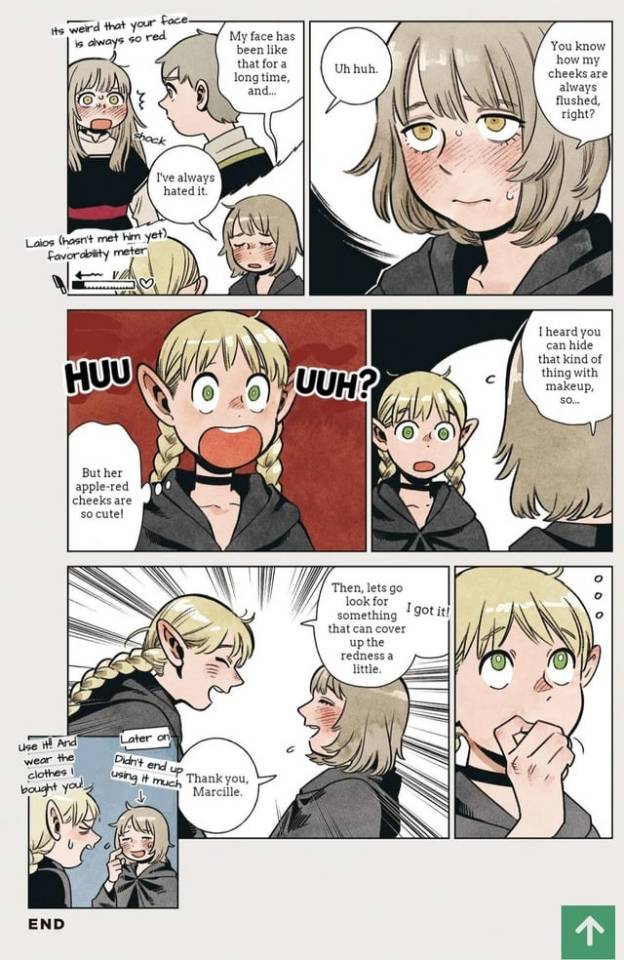
Here’s a link to what I mentioned about her being uncomfortable wearing feminine outfits. It does seem to be more about comfort than the aesthetic perse, to me. Interestingly the shirt & shorts don’t seem like they show much more skin than her beach outfit, so maybe it’s more about the shirt and shorts being tight-fitting. Like the skirts and heels they feel stifling. Again a bit with themes of freedom and not wanting an aesthetic pushed onto her. So yes just to reiterate, I think this is more about self-affirmation and how her identity and self-image gets shown to others, rather than wishing to hide parts of her body like her blushing etc for people pleasing reasons. Makeup was a way for her to appear how she wants to and feel more confident. It was a way to take control over her own image. She didn’t keep doing it, the narrator stating the process to be ‘troublesome’. Ultimately she still prioritizes her comfort, and it was a lot of recurring efforts to go through.
And on the topic of appearances… A friend once asked me: "Does she really hide herself or not? I keep thinking about "falin is herself first and foremost" (in her Adventurer’s Bible profile) it’s just so. Hmmmmmmmm... I just keep seeing people say she hides her real self from people when I feel like the issue is more about her charitable traits straying too far into becoming flaws but people around her dont realize that..."
Imo the thing is, I don’t think she hides her identity, but I do think she suppresses her individuality for others’ sakes if that makes sense. In the way that only post-canon does she allows herself to go see what the world is like, but that’s not personality wise it’s needs and wants wise. And I do feel like that’s the closest interpretation of canon, she says it herself she doesn’t know what she wants because everything she’s done was always about Laios or Marcille, but she doesn’t change her demeanor or personality for others. But she *will*, like, not ask for things she wants directly, like sharing lunches with Marcille at the academy, she suppresses her wants, doesn’t ask things from people and doesn’t hope for more, hope for better. I don’t think we ever see her actively repress her personality, except like what, being more laidback than enthusiastic but I do feel like unlike Laios with her it’s less ‘appearing stoic to fit in more’ and more ‘yeah i’ll just chill until I’m needed or something activates my enthusiasm’. To which said friend quoted: "to feel like you belong you need to be useful. when you can’t be useful the next best thing is being convenient."
And speaking of passivity… I want to speculate about Shuro’s proposal some more. Shuro and her got along well though we don’t know how much, or how often they hung out, she even saved him from a nightmare. Why did she take so long answering Shuro’s proposal? Was it an effort to preserve or was she really just that conflicted? Procrastination probably yes, but what is the core motivation of itl Considering she ended up saying no to travel the world instead, I don’t think it was as simple as ‘she wanted to say yes for convenience’. Logically it’s what would have been best, but it’s not what she wanted for herself, but it was and still is hard for her to even know what she wants. Probably, since like she states it was a great offer and she doesn’t think she’ll get proposed to again, it’s that self-effacing tendency that yes it’d be convenient and logical, and that makes her want to say yes even if her spirit isn’t in it, because if it’s convenient then that’s more important than her feelings on the matter. Man also… Obviously Marcille is very vocal about how she shouldn’t get with Shuro, but imagine how Falin’s whole perspective on marriage must have felt when her only friend ever is a Romantic with a capital R who gushes about idealized romances and grand gestures and True Love and doing things with fully pure feelings all the time.
AND speaking of passivity!!! How much Falin is "there" as the chimera, just how much she’s master of her actions, is left ambiguous and intentionally so imo, but she’s for sure there & influencing the dragon’s action to some degree. Having a dragon’s foot on her in purgatory that keeps her from moving for sure visualizes how it must have been like, but there’s Falin calling out to her brother Laios, there’s the kind attentions towards Thistle that are so Falin-like, and most explicitly there’s the Adventurer’s Bible stating "Even after becoming a chimera, she has a soul that's as kind as ever", which I honestly dislike, a fantranslation puts it as "Even as the chimera, her caring nature remains" and either way to me it feels like confirmation that it’s her giving those berries to Thistle. Now, wether or not she has the mental capacity of a chicken or something closer to human Falin, no clue, there has to at least be some kind of mind bond between monsters and the dungeon lord, compelling or forcing them to go along with orders, or calling her to him in distress like with the fight on the first floor. But yes, it’s interesting to wonder what it is that a Falin, with her kind soul but without her human mind, would willingly do. On her profile, she’s described as Thistle’s guardian and servant. The power dynamic between the two are very interesting, I already went into how it might have felt like freedom to her while being fake so I’ll reign myself in and just mention it again. She’s still at the heel of someone, only now it’s someone who doesn’t care about her back. Going from being cared for so strongly that it’s suffocating and they would defy death and the world for you, to being devoted to someone who has not one feeling about you besides your utility as a paw . She has all this care to give and to focus onto others and he has none to send back to her and I think that’s part of it. In a way, being left with only her own feelings and a void, without expectations or feelings or ideals pushed onto her, it might have been soothing in itself, and eye opening. But yes the way I think of it, her care for Thistle isn’t unlike the care she gives the ghosts.
Interestingly, the care she extends for the ghosts is sending their soul to a peaceful death, freeing them, of life and any earthly attachment. Take that as you will with the themes of freedom and burden of life and mind, immortality and becoming a warped version of who you were, and such and such.
But going back on the topic of connections and bonds for a bit, I think academy days Falin & Marcille is super interesting bc we’ve never really see Falin form a connection besides with Marcille and even that is kept pretty ambiguous. When was the point that Falin started seeing Marcille as a friend and seeking her out? When was the "I’ll lay down my life for you" point? I’m so fascinated by how she wanted to share lunches with Marcille but never truly asked, only made little "hey want this? I found it isn’t it cool?" gestures of showing things to her… It’s the only way she knows to ask, or maybe it’s the only way she feels comfortable to. In all the scenes of young Falin and Marcille Falin seems comfortable in her friendship with Marcille, but at the same time… I think we see Falin at her most insecure around Marcille, because she really does care about Marcille and what she thinks of her so much, and while Marcille is a bit of an unstoppable force tornado style (affectionate) Falin is something of a doormat. I’d usually say showing her berries was her earnest way to connect and be like "Hey bestie look at this! :]" , but there’s a real possibility that she was self-conscious and holding herself back.
Friendship and Marcille! Involving Laios into this too but, again with the autism thing of not showing you care in ways that others understand, Marcille being very overtly affectionate and clingy was so so soo important… Marcille keeping on hanging out with Falin and caring after her, and being undeterred/unbothered by Falin not always seeming like she cares all that much back in the conventional way, as in Falin acts nonchalant and a bit like she didn’t mind wether she was there with her or not during her outings to the cave dungeon. Caring and being clingy and so affectionate despite that in such a classic Marcille way is soo needed, because so often people will get discouraged by say, their friend not keeping in contact regularly/well, seeming disaffected or as happy-go-lucky as ever even if you haven’t seen each other in a while or when they’re alone, and yes there’s potential for a strong friendship there but someone like Falin won’t be committed enough to reciprocating attention the same way… I hope I’m making sense but yes this angle in particular strongly correlates to autism. And the way Marcille always initiates physical affection, both Toudens being awkward about initiating touch because they don’t know if that’s allowed, if they’re going about the social interaction the right way, if they’re allowed to ask that out of someone…
Another fun observation to make is about the 4 years Falin and Marcille spent apart. Marcille despite being of a long-lived race treated these 4 years of separation with more gravity than Falin did. Falin brushed it off very dismissively to say the least. But then you remember that the amount of time Falin and Laios didn’t see each other after he left the village was 8 years. Double the years, double the time. And that reminder makes Falin’s actions so starkingly understandable. Of course she wouldn’t see 4 years of separation as a long time if 8 years of separation with her beloved brother is her point of comparison. Of course she’d see it as worth it to leave Marcille for 4 years if it meant ending those 8 years instead, especially if she was worried about him (the reason why she followed him into his caravan job).
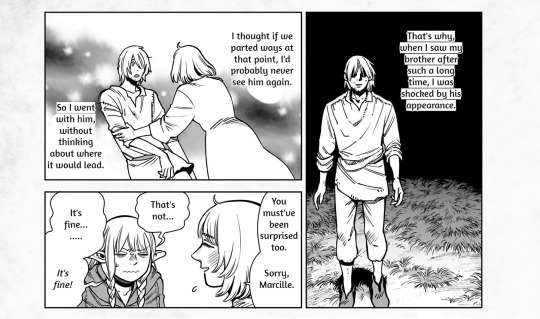
A friend always says that while Falin is the center of Marcille’s world, Laios’ is at the center of Falin’s, and I tend to agree.
It’s fun to think of how her career dreams had always been shaped by Laios, even when they were kids. Of course there’s how traveling the world began as a dream they talked about and shared, but there’s how he reassures her by listing cool jobs she could do like traveling exorcist, etc. And then of course, she gave up on her magic academy and career path to follow him and do odd jobs, etc etc.
I should go into the violence of Faligon more tbh, because I think there’s an interesting parallel to how she has no problem wacking things with a mace, wether a ghost when she was a kid or a walking mushroom as an adult. Something that often surprises fans when they remember, I don’t really want to get into the whole " Falin hates violence and hates seeing people in pain to an intense degree. ‘If you die do it somewhere where I can’t see’ style’ interpretation, it has some weight but on the whole I don’t vibe with the theory she has a particular aversion to violence, she seems to be fine resorting to it as much as any other adventurer as long as it isn’t needlessly against ghosts. And Falin’s sudden mace hits are fun to me too because it’s not her becoming a berserker when the need arises as much as her becoming active because something she cares about is threatened, and that brings her out of her passivity from 99% of the rest of the time. Thistle included. Falin always could be violent, she just dislikes senseless carnage. The Shuro party vs chimera fight is a bit ambiguous on it, because you can argue she only attached after being provoked, presumably offscreen as well while the ninjas went off to fight the harpies. Falin becomes the most active when she needs to protect someone, she has no qualms doing whatever’s needed for that, wether it be leaving the academy & Marcille without notice no matter the consequences or what her parents think, or teleporting the party, etc.
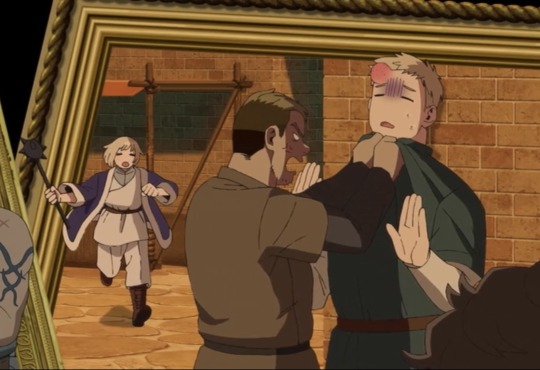
I’m working on a post specifically pointing out all the differences between Falin and Laios, but yes I think both of them selfishly desire freedom in different yet similar ways. Falin’s dark secret is "Ethics and risks are optional if it means I can protect those I love" like the teleportation, and Laios’ is "Ethics and risks are optional if I can be free of all this bullshit" aka humanity aka his wish with the winged lion.
Conclusion
Flighted birds have hollow bones. With freedom and wings there comes risks and sacrifices.
Tldr: Falin doesn’t care all that much, she’s very go with the flow. For example if someone hates her she doesn’t really care because that’d require her caring about what they think of her in the first place, and she only cares about her loved ones. She smiles, but it’s more a state of being rather than out of active goodness: she’s canonically very genuinely kind, but it’s more out of a general want for pleasantness than active care itself. She’s passive, and softspoken because that’s just how she seems, but she has no problem hopping into bushes or getting heated if something calls to her enthusiasm or calls for action and a hit of the ol’ mace. Her loved ones needing tending or protective is what makes her go from passive to active. That familiar autopilot mode of making someone the center of her world and following their every move is what made her so easy to be controlled as the chimera, even ferociously defending him with her life. Faligon is most interesting to me with the theme of freedom. She’s shackled to Thistle and out of her mind, but there’s also a sense of empowerment and freedom from expectations and society. She spends all her time caring for Laios and Marcille alternating that none of her care and emotional energy is left for others, including herself. So she had to get relieved of all of that for a bit, becoming the chimera so she could reset and recenter and remember that she, too, indeed, is there and an important part of her own life. There’s a way of caring after others that can be selfish, not unlike Marcille being overly coddling and not listening to Falin. In Falin’s case, I think it was so selfless that it ended up looping back around to erasing her sense of self. In losing sight of herself, that devotion becoming neither quite selfish or selfless but a fact of life and a state of nature, muddled by its lack of direction.
She’s sooo used to never being able to ask things out of others, you get the crumbs of affection and approval that others offer to you unprompted and that’s it don’t hope for more don’t ask for more. (Also reflected in how she follows her loved ones around without complain or personal opinions and how she’s not willing to rock the boat and affirm herself in her relationships like with Marcille during canon)
Falin cares so much, so much and so laser focused on her few loved ones that it blinds her and she loses sight of everything else, she ends up neglecting herself and the rest of the world. As Kui puts it, Falin is herself first and foremost. She just had to remember the importance of that.
-
I see her as an enneagram 9, which can be surprisingly accurate and fun to research through the lense of Falin. Excerpt below from this book, but like my god, good way to put it
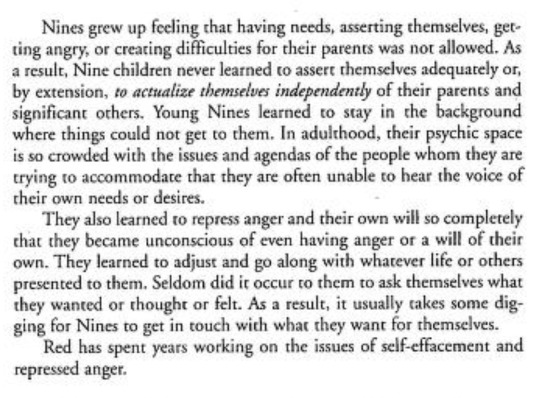
That’s it, ty for reading. Even if it’s a bit of a mess, hopefully you’ll have gained a thing or two from it. Falin is a character hard to pin down, but it is very gratifying when you find the way that the puzzle pieces fit together right for your own understanding of the story. Fantranslation of the shuro proposal comic by @/thatsmimi here.
Here’s my spotify playlist for her if you’d like
Sometimes love is about letting go, a lesson a lot of the cast needed to learn. Self-love’s important too, and just like with diets we need a healthy balance.
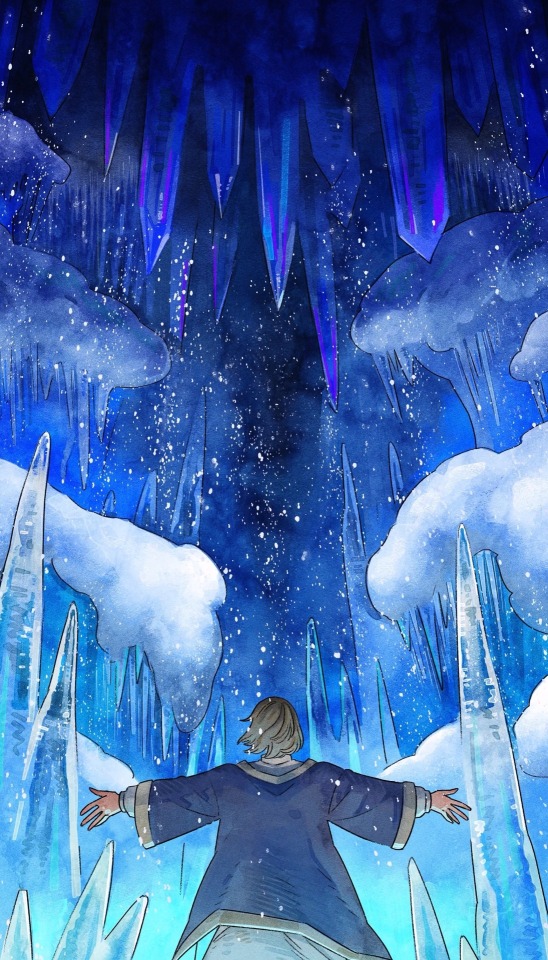
#I find it hard to express myself right on the topic of Falin. Both because the issue is pretty vibe based and because we don’t#get that many moments with her. So there’s ambiguous scenes up to interpretation addressing a layered topic and like. Save me. Save me#As always falling down the rabbithole of starting an analysis about a specific facet and then needing to explain everything else around it#I’m doomed. I’m getting lost in the sauce.#dungeon meshi#delicious in dungeon#falin touden#analysis#character analysis#meta#autistic reading#aroace reading as well. Sort of. It’s mentioned#The aroace autistic guilt of not caring back in the way/with the intensity you’re expected to#As always this is just my interpretation blablabla#Spoilers#dungeon meshi manga spoilers#She loves like a dog aka unconditionally and happy with eating scraps of affection and attention off the floor#Laios touden#he’s here too bc they are an unit#If you’re not capitalizing on the uncanny vibe autistic effect for Falin’s character u are missing an opportunity imo#Fairy’s child is written all over her. Her cryptic-ness is the point so why am I surprised she’s hard to fully pin down#Even with the graveyard scene it was Falin following Laios… Sob. Laios could feel responsible her powers were found out#I’d like to rework this at some point if i get better at structuring. I’m not satisfied by the level of clarity#Will 90% for sure edit stuff in if i find more to say.#Fumi rambles#Crazy style#I give a TLDR at the end if you’d prefer. It doesn’t have the like evidence/explanations alongside but it makes the main points i think
1K notes
·
View notes
Text
Based on the responses to my post yesterday wanting to know more, here's my guide to
🧑💻Code in Hermitcraft (and other SMP) Fanfic🧑💻
Note: This is just the interpretation of one Jr Software Engineer. If other developers have a different interpretation, I'd love to hear it in the comments or reblogs!
It's super common in Hermitcraft (and I'm assuming other SMP) fanfiction for the plot to revolve around errors in the game itself and how they affect players. The problem is, as a software engineer, this almost always immediately pulls me out of the story as the ways the game errors are described frequently don't make sense.
This is not a condemnation of writers who use game bugs as parts of their stories, as nobody expects all SMP fanfic writers to have a CS degree. Some even do it well and I adore those stories when I find them! But here are some high-level suggestions to have your glitchy plot points make a little more sense. Usually, it's just a slight change in wording that's required.
Code vs Data
"His code is glitched! He's evil now!"
"They carefully pulled at the strands of her player code, trying to find the bug that was causing her pain."
"Wow, your code is so ancient! You're from Alpha, right?"
These sorts of phrases are probably the most common ones I see that yank me right out if a story. Why? Because they're confusing data and code!
So, what is the difference?
Think of code in this scenario like the laws of physics. It's the rules that guide what can and can't happen in the world. It's what says "if you walk, you move forwards", "if you eat, you'll be less hungry", "if you use a shovel on a dirt block, it will end up in your inventory".
Data is the actual "stuff" in the world that the code changes via its rules. Data is the specific blocks in that building, that item hovering above the ground, the mobs staring at you from under the trees, the player character, the player's health, the player's inventory, the player's skin, and, in the fanfic context, the player's personality and memories.
In other words, if it's an action that can happen, it's probably code. If it's a specific thing, it and everything that makes that particular thing unique is data.
Of course, there can be bugs or glitches in the code which means that data does something it shouldn't, such as "if you put some TNT, some dead coral, and a minecart in this very specific configuration, you can duplicate the TNT." In this case, the act of duplication (ie the rules that let duplication occur) is a glitch in the code (the rules allow something they shouldn't), but the duplicated TNT itself isn't code; it's data. Data that shouldn't exist but does anyway because of that glitch in the code.
So, how could you rework the sample phrases above to make more sense?
"He got too close to a glitch, and his personality data got corrupted. He's evil now!"
"They carefully prodded at her player data, trying to find the broken property that was causing her pain."
"Wow, your data structures are so ancient! You're from Alpha, right? I can't believe you've survived so many updates without compatibility issues!"
Code vs Logs
"Xisuma looked through the code to find the source of the glitch."
This one's a little less clear cut, as there are circumstances where players could look at a version of the code. Some of the Minecraft code is Open Source (ie free to look at), and the rest can be decompiled from the Minecraft .jar (ie turned from machine-readable ones-and-zeroes back into words and stuff, although much less human-readable than what the original code would have been). The super-technical players such as the SciCrafters and I think Doc too will look at the code, which is how they make their super efficient farms and find and exploit glitches to, say, put 8 spawners in one chunk.
But generally, the code is not the first place you go when encountering a glitch. I mean, if it were that obvious from the code alone, it probably would have been caught before being shipped!
When something goes wrong, the first place to look is the logs. The logs of what the players have been doing, the logs of previous commands that have been run, the update changelogs for the game, the version history of the (admin-editable) config files, any warnings or error logs from the server itself. For example, if you have a malicious user such as, say, a Helsmit in your story, the logs would show when they entered the world and where, unless they also did something hacky to cover their tracks.
Personally, I also wouldn't say you'd have to stick to exactly what a server would realistically log if it makes your story more interesting. It's easy enough to hand wave that an admin has a mod in place that surfaces more information if it'd make the story better!
In a multi-server setting, this is also the point where the admin of your world could also reach out to the admins of other worlds and discuss if they've seen the issue before and how they solved it. The in-universe equivalent of looking it up on Stack Overflow or Reddit if you will!
Once the admin has looked at the logs and maybe chatted to others, if they still can't fix the issue via commands or config file changes, then it might make sense for them to try looking into the code if they can. Note that not all server admins are necessarily confident at programming as it's not a core part of their job.
But at the very least, at this point the admin should have a better idea of what part of the code could be bugged. This will make it easier to either a) make a patch for the bug or, more likely, b) understand what circumstances trigger the glitch and avoid those circumstances.
TL;DR: The code is not the first place admins will go when glitches cause issues; the logs are!
And as before, example sentence:
"Xisuma trawled through the logs, trying to find any indication of the source of the problem."
To Conclude
Code is the rules that govern what stuff can do and how stuff interacts. The stuff itself is data. When something goes wrong, that typically results in the data being in a state it shouldn't be in, wether that be because that thing's velocity is much higher than it should be after taking advantage of the ravager flight glitch, or because a player and a mob's data structures got combined on accident to leave them a player-mob hybrid.
Of course, this broken data is likely caused by a bug/glitch in the code. It could also be caused by somebody malicious who's purposefully trying to break things by messing with the memory in another way. It could also be because a cosmic ray hit a piece of RAM and flipped a single bit (this is an actual thing that happens believe it or not).
Either way, when something goes wrong, the admin's first point of exploration is the logs, not the code. The logs will give the admin a better idea of what the cause of the issue is, and talking with other admins could give them a solution without ever touching the codebase. But worst-case scenario, it is indeed possible for an admin to go spelunking through the codebase to find the cause of an issue and create a patch for it.
This just covers the most common code-related plot points that I personally see in Hermitcraft/other SMP fanfiction. If you have any further questions about writing code-related plot points, feel free to ask! And also, just to reiterate, this is all just my interpretation. Others may interpret differently, and if you do, I'd love to hear what your alternative interpretations are!
PS: I was also planning a section on hacking here, but this post is already getting long and that's complicated, and also I'm bad at hacking. But let me know if you have any questions related to that that you'd like to see in a follow-up post!
#and yes I did write this when I was supposed to be coding for work#hermitcraft#mcyt#shamelessly maintagging in case others find it useful#res writes#res rambles
1K notes
·
View notes
Text
How to Write Dialogue, Part 1: Natural Speech, or Making Your Characters Sound Like Actual People
So a lot of creative writers struggle with dialogue, and it’s one of the things I actually find easier. I’ve learned a lot from various pieces of writing advice on tumblr, so I figured I’d contribute my bit as well. Some of my basic tenets for writing natural-sounding dialogue:
1. Actual people do not always talk in full, grammatically correct sentences.
When we talk to one another, we rarely use proper written grammar. We drop articles, don’t finish our sentences, abbreviate words, etc. Consider this exchange:
“Hey, what are you doing after school?” Aliya asked.
Leanne looked up at her friend. “I don’t know, why?”
“A couple of us are getting ice cream. Steve’s driving; do you want to come?”
“Sure. Hang on, let me just tell my mom.” Leanne pulled out her phone and sent a quick text. “Okay, I’m ready to go.”
“Cool,” Aliya said. “I have to grab my bag, so I’ll meet you outside in five minutes, okay?”
And now this one:
“Hey, you doing anything after school?” Aliya asked.
Leanne looked up at her friend. “Dunno, why?”
“A couple of us are getting ice cream. Steve’s driving; wanna come?”
“Sure, hang on, lemme just...” Leanne pulled out her phone and sent a quick text to her Mom. “Okay, yeah, I’m good.”
“Cool,” Aliya said. “I gotta grab my bag, so meet you outside in five?”
Which sounds more natural? Which feels more like teenagers?
That’s not to say that your dialogue should never be grammatically correct or include full sentences. In fact, grammar can be a useful way to signal how formal or casual a situation/relationship is. If your sibling asks if you’re busy, you might respond, “Nah, I’m free, what’s up?” but if your boss asks, you might respond, “No, I have a minute. What can I do for you?” Your speech becomes more casual when you’re comfortable or when you’re talking to someone you know well. Your speech becomes more formal when you’re in a stricter environment or when you’re talking to someone you want to impress.
2. We almost never say people’s names when addressing them.
One of the most common habits of inexperienced writers is to have everyone calling each other by their names all the time. In reality, we almost always use names when referring to someone we’re not talking to.
Generally, if we’re using a person’s name as a direct address, it’s for one of the following reasons:
We’re getting their attention (“Hey, Sarah, can you come help me?”)
We’re giving a piece of information to just them, rather than the whole group (“All right, everybody ready? Sarah, you lead the way.”)
We’re trying to really drive an important point home, particularly one we’re making in anger or frustration (“For God’s sake, Sarah, I’m doing my best here!”)
Other than that, we pretty much don’t say people’s names to them, so your characters shouldn’t do it either.
3. Break up dialogue with action.
Nothing makes a reader’s eyes glaze over like huge blocks of text. We know this when it comes to description--how often have you tried to read a book with huge, dense paragraphs on clothing or weather or social structure or any number of other things--but it can be true with dialogue too. Even if the focus of your scene is a conversation, we need action to ground us in the scene. If your characters talk for too long without a physical check-in, we start to find it difficult to “see” them. When we experience real interactions, we process dialogue and visual stimuli simultaneously. Threading them together in your writing will make it feel more real to your reader.
Consider this quick scene:
Adam walked into the kitchen to find his mom sitting at the table, reading. She looked up when he entered.
“Mom, I need to talk to you,” Adam said.
“Sure, what’s up?”
“Lisa might be pregnant.”
“Okay,” Mom said, her voice even. “She doesn’t know for sure yet?”
“No,” Adam answered. “She got a pregnancy test after school. She said she’ll text me right after. She’s three weeks late, though, so.”
“So,” Mom agreed. “Thank you for telling me. If she is pregnant, you know I’m always here. Whatever you two want to do, I’ll help you figure it out.”
The scene is all about the conversation between Adam and his mom, so it makes sense for the focus to be on the conversation. It’s also not a scene where they’re moving around a ton. However, little bits of action can not only ground the scene for the reader, they can also provide additional information and insight. Let’s make some little changes:
Adam walked into the kitchen to find his mom sitting at the table, reading. She looked up when he entered.
“Mom, I need to talk to you,” Adam said.
Immediately, Mom closed her book and folded her hands on top of it. “Sure, what’s up?”
“Lisa might be pregnant.”
“Okay,” Mom said, her voice even. “She doesn’t know for sure yet?”
“No,” Adam answered, sitting down across from her. “She got a pregnancy test after school. She said she’ll text me right after. She’s three weeks late, though, so.”
“So,” Mom agreed. “Thank you for telling me. If she is pregnant, you know I’m always here. Whatever you two want to do, I’ll help you figure it out.”
I only added one action for each character, but see what they do to the scene. In the original, we hear Mom welcome Adam’s need to talk to her, but by adding a bit of physicality, we can see clearly how she recognizes his serious tone and immediately gives him her undivided attention. This lends specificity to this interaction, but it also gives us insight into what kind of mother she is in general, and makes it feel believable that he trusts her enough to come to her for this in the first place.
Adam’s action is tiny, just sitting down. However, it clarifies a few things for us. First and most obviously, we say what he’s doing. In the original, since we don’t see him sit, it’s left unclear whether Adam stays standing or joins his mother at the table. In the revision, we not only know where he is, but the placement of this action colors his emotional state. He blurts out the crux of his problem immediately and bluntly, perhaps to just get it over with, perhaps because he’s worried he’ll lose his nerve. Then, once his mom reacts well and they need to talk details, he sits down to continue the conversation.
Little actions like fiddling with something, brushing hair/sweat out of your face, closing a door, sighing, glancing aside, shifting in your chair, pouring yourself something to drink, etc. can ground your reader in the scene and remind them (and you!) where the characters are. They’re also a way to use your characters’ body language to say things that aren’t (or shouldn’t be) present in your dialogue or speech tags.
4. When in doubt, read it aloud!
The easiest way to find out if your dialogue sounds natural is to listen to it. You can read it on your own, or even better, with a friend to play each character. Read just the speech, not the dialogue tags or descriptions. How does it sound? How does it feel? Is there anything you’re tempted to phrase differently from how it’s written? Are there times one character responds to the other in a way that doesn’t quite fit or make sense? Obviously your characters may have different speech patterns from yours, but generally, if you stumble over something in the conversation, they will too. It’s worth reworking it into something that would more naturally fit into your own mouth, and therefore into the mouths of your characters.
477 notes
·
View notes
Text
The Witcher: The Games vs The Books
Coming to the fandom this late, I can only assume the relationship between the Witcher games and the original novels has been long since talked to death by others. But I'm far too fascinated by the whole glorious mess that is this canon not to want to get down some of my own thoughts about how it all fits together.

See, on the one hand, the games (Witcher 3 especially) are arguably only too dependent on the novels to stand alone. They do a wonderful job of picking up a number of unresolved plot points the books left hanging, and a woeful job of explaining so much a player coming in cold would really like to know – Ciri's history with Geralt, Yennefer, her powers and the Wild Hunt itself just to begin with. This is an issue that only increases as the games go along: cliche as Geralt's amnesia may be, it's used to good effect to introduce the world to the player in the first game. By the third, Geralt has all his old memories back and two extra games worth of new experience, and good lord is it all alienating to the newcomer.
On the other hand, so much about the games (again, the third especially) contradicts the novels in painfully irreconcilable ways. That wouldn't necessarily bother me – adaptations are allowed to rework and reinvent, stories can and should evolve in the retelling – except, well, see point one above. So you're bound to come out of the games with a lot of unanswered questions if you haven't read the books, and just as many if you have.
Spoilers to follow, of course, for both the books and the games.
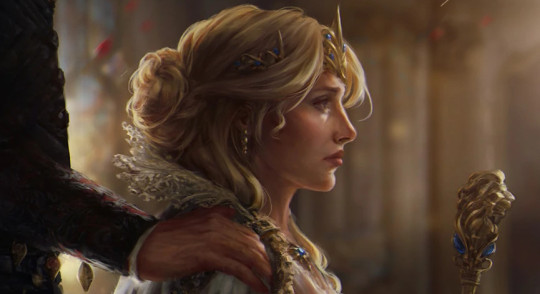
Here's one of the big ones: just how did the world – Ciri included – discover that one of her long-presumed-dead parents was actually alive and well and now ruling the entire empire of Nilfgaard? Fucked if I know. Neither the games or the novels have any explanation. In the novels, in fact, the world at large believes Ciri is married to the emperor of Nilfgaard. Naturally, this 'Cirilla' is a fake, but the scandal were the full truth ever revealed would redefine Emhyr's reign. Yet somehow, in the games, everyone seems to know he's Ciri's father, and that whole awkward incest angle is never mentioned. Continuity has been tweaked pretty significantly, and it's left to the player to guess how. If that wasn’t bad enough, the games apparently still included a Gwent card of the fake!Cirilla (artwork above) just to ensure maximum confusion.
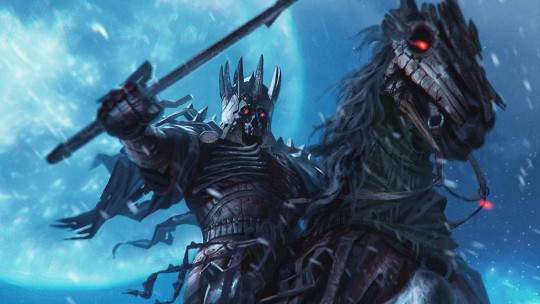
Before I get too sidetracked with all that stuff that doesn’t add up though, there really is a lot to be said for what does work about how the games expand on the plot of the novels. The Wild Hunt itself is the big one. The spectral cavalcade appears several times through the novels and hunts Ciri across multiple worlds in the final book before apparently losing her trail and vanishing to make way for the 'real' big bad, never to be mentioned again. While TW3 left me pretty underwhelmed by the revelation that the spectral Wild Hunt were just a bunch of dark elves in skull armor, the books had introduced the Hunt and let us spend some time on the dark elves' world before we get the reveal that the two may be one and the same. So for all the ranting I could do about missed opportunities regarding the Wild Hunt, they're the natural candidate for the games to pick up on as their new big-bads.
To my surprise, Geralt and Yennefer's "deaths" and subsequent recovery in pseudo-Avalon also comes straight from the novels. That everyone thinks Geralt dead at the start of the first game isn't, as I'd first assumed, a convenient excuse to have him reappear with amnesia, but simply how the novels end. Why Ciri leaves them and goes world-hopping isn't clear, but "because the Wild Hunt was after her again" is as good a theory as any. So, another point to the games there.
And there's so much more. The Catriona plague has only just appeared at the end of the novels, but we know it's posed for a major outbreak – one that’s in progress by the time of the games. The second game in particular does a terrific job of taking the ambitions of the expansionist Nilfgaardian Empire and the still-relatively-new Lodge of Sorceresses and building an entirely new conflict around them – even taking two of the least developed members of the Lodge (Sabrina Glevissig and Síle de Tansarville) and expanding them into major players. Dijkstra similarly ends the novels on the run from those in power, and having already taken the same assumed name 'Sigi Reuven' he's using in the games – while the books assure us that prince Radovid will grow up to pay back his father's assassins (ie. Phillipa) and become Radovid the Stern.
The twisted fairy tale origins of the novels are something the games actually seem to have gotten better at as they went on: the 'trail of treats' to the Crones is the great example, the monster-frog-prince and the land-of-a-thousand-fables of the expansions are two more, and many more are hidden in sidequests. And I'd be remiss not to mention that in again asking Geralt to pick a side in the conflict with the Scoia'tael, the first two games not only recreate a scenario Geralt repeatedly deals with in the books, but a major theme. It's interesting too how much the broad structure of the third game feels like an homage to the books, with Geralt searching for Ciri, interspersed with sections from her POV. You can nitpick the detail of any of these examples, but the intent is unmistakable, and a lot of credit is due for it in the execution too.

Some of the detail that's gone into translating the world of the Witcher books into the games is just insane – not just in the geography and history of the place, but right down to the names of the wine you can pick up. There's the fact the Cat potion makes Geralt see in black-and-white, or the fact the basilisk and cockatrice monsters are clearly based on the same model, but the basilisk is reptilian where as the cockatrice is more avian – which is exactly how Geralt describes the difference between them in The Lady of the Lake. There's a point where Book!Regis recounts a detailed list of all the lesser vampiric species, ending with the only two violent enough to tear apart their victims: almost all can be encountered in the games, and the last two (Fleders and Ekimma) are indeed the most animalistic. This kind of thing is everywhere.
My favourite examples tend to be those that blend into the background if you haven't read the books, but will get a grin from those who have, such as a peasant in Velen who will call out to Geralt (paraphrased from memory, alas) "Sir, sir! We be up to our ears in mamunes, imps, kobolds, hags, flying drakes... oh, and bats!" – which is a lovely little reference to a couple of conversations from Edge of the World wherein Geralt explains that most of the monsters the locals want him to take care of don't actually exist. Or all those soldiers chanting "Long live King Radovid!" – natural enough, but it takes on a whole new life if you've read the passage in Lady of the Lake where the young prince Radovid grumbles internally about having to sit and listen to the city chanting 'long live...' to every other notable figure present except him.

Really, it would be faster to list the things the games introduced that don't come from the original source material in any obvious form, because it's a struggle to come up with very many. The villainous Crones of Crookback Bog and Master Mirror of the Hearts of Stone expansion are the biggest ones that come to mind, along with a great deal of the vampire mythology from Blood and Wine. To the witchers themselves, they’ve added mostly game mechanics: the use of bombs and blade oils, the names of most of the potions, and three new witcher schools (all with their own specialised gear). There are a number of new creatures and monsters – Godlings, noon-and-night-wraiths, botchlings, shaelmaars and so on – and though trolls are mentioned in the books, the games take credit for giving them so much character. Obviously, there are new characters, like Thaller and Roche – but not technically Iorveth, because a Scoia'tael commander of that name is mentioned in the books, if only in passing. And already, short of just listing off every new character the games introduced, I’m running out of ideas. Credit where credit’s due on that front: most of the new characters and locations they’ve created feel authentic enough that Kalkstein or Thaller would be right at home in the novels’ world.
But for all their dedication to the detail, it's hard to feel like the games have really managed to capture the spirit of the books in their storytelling: the mundanely corrupt bureaucracy that does so much to bring the world to life, or their cheerfully cynical sense of humour, or the flamboyant wonder that is book!Dandelion, or their enthusiasm for putting women in positions of power, or the bigger themes about the differences between the story that gets sung by the bards and what really happened – or so much else from the novels that came as such a surprise to me when I started getting really sucked in.
And if we’re going to talk about all the little things they got right, it’s only fair to point out there are just as many little things they got wrong, and sometimes pretty glaringly at that. "I thought you bowed to no-one" says Emhyr to Geralt – almost as if book!Geralt doesn’t happily bow in most every situation where it would be polite or diplomatic to do so. "This would never have happened if the council was still around!" says Geralt upon finding a sorcerer's lab full of human experiments – as if none of his experiences with Vilgefortz or the wizards of Rissberg ever happened, back when the council was very much still around. In TW2, he mocks the idea of a woman like Saskia leading a rebellion – almost as if women like Falka and Aelirenn haven't led some of the most storied rebellions in history (and we can't even blame the amnesia, because Geralt himself mentions Aelirenn later – oh yeah, this one annoyed me particularly).
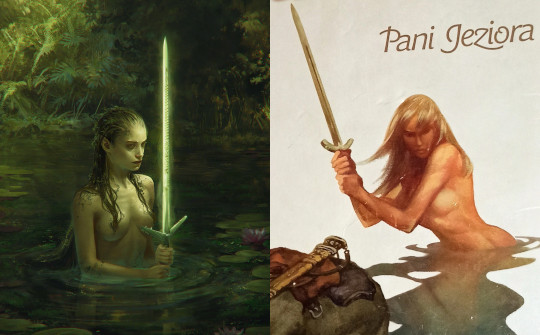
Book!verse 'Lady of the Lake' is basically just Ciri being surprised while bathing
Yennefer's studious aethiesm and willingness to desecrate Freya's temple is entirely in character – but only if we forget that she had her own personal religious experience with the goddess Freya herself in Tower of the Swallow. And then there’s the fact the Lady of the Lake is now a literal lake nymph who distributes swords to the worthy, as if no-one writing for the games ever got past the title of that particular Witcher novel (let alone got the joke). And the list goes on. It's easy to get overly caught up in contradictions like this – it's hardly as if Sapkowski's novels don't contradict themselves in places, as almost any long-running series eventually will – but it's going to stick out to those who’ve read the novels nonetheless.
While we're talking about how the games pick up where the books left off though, the big contradiction that has to be touched on comes in bringing Geralt back at all, at least in any public capacity. There's plenty to suggest that Geralt survives the novels' end and even goes on to have further adventures, but it's also pretty explicit that the history books record his death in the Pogrom of Rivia as final. The last two novels by order of publication (Season of Storms and Lady of the Lake) go so far as to feature characters far in the future with an interest in Geralt's legacy, and they discuss the matter in some depth. As far as the world knows, Geralt is dead.
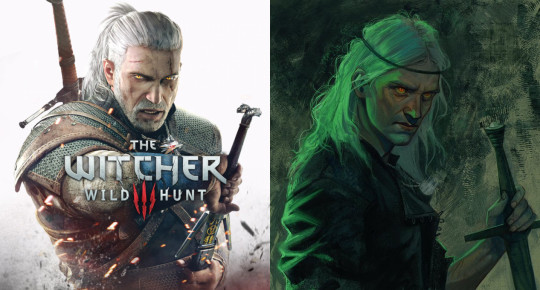
Book!Geralt fanart by Diana Novich
But it's hard to blame the games for ignoring this – true, thanks to Geralt's longevity, they could have set their conflict many more years after those future scenes – maybe even used Ciri's established time-travel powers to let you pop quietly in and out of the past (and, okay, now I've thought through all that, I'm kind of sad they didn't). But there comes a point where that kind of slavish devotion to preserving the source material really doesn't do a story any favours, and I'm not sure I could name any other successful adaptation that's bothered.
Besides bringing Geralt back at all, most of the bigger changes pertain to Ciri. In fact, as much as I'm about to get deep into the nitpicks below, you can make a surprisingly good case that the games have made only one really big change, and that's in simplifying the prophesies surrounding her. See, in the novels, all those world-saving prophesies aren't technically about Ciri, they're about her as-yet-unborn child. Who gets to impregnate her is the big driving force behind most of the villains of the books – one that all the main contenders seem to see as more of an awkward necessity rather than the inspiration for violent lust, but even so. To Emhyr, having to marry his own daughter is a bug, not a feature – but he's willing to do it to become the father of the savior of the world. But if Ciri is capable of fulfilling those prophesies herself, then Emhyr is already the father of the savoir of the world, and the revisions to his relationship with Ciri start to make a lot more sense.
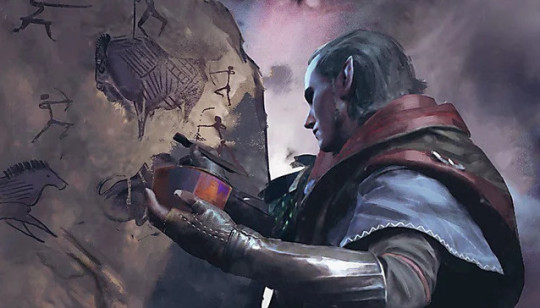
Ciri's history with the Aen Elle elves seems to have been similarly revised – if not quite so cleanly. Avallac’h and Eredin are, naturally, both book characters – in fact, a lot of personality has been left behind in the books, since Avallac’h originally had a rather camp flair, and Eredin is less the power-hungry kingslayer you might imagine. When Geralt meets Avallac’h in the books – which happens briefly in Toussaint, for one of those "everything you're doing is going to make everything worse because prophesy" conversations – he's busy decorating a cave with fake prehistoric paintings in the hope of confusing future explorers. (Surprisingly, there does seem to be official art of this moment on one of the gwent cards – see above – though the Avallac’h who jokes about adding erect phalluses to the picture and admits his vanity won’t allow him to resist signing it hasn’t entirely survived the transition to the new medium).
We also meet the former Alder King, Auberon, whose death we see in flashback in the game. (Fun fact: Auberon is actually blowing bubbles through a straw in a bowl of soapy water when we first meet him in the books, hence the straw in the illustration below. The books just have more whimsy than any of the games would know what to do with.)
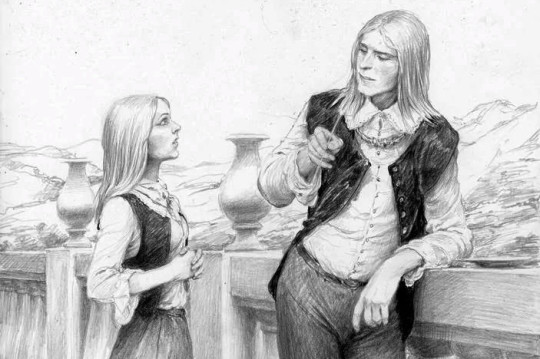
Ciri spends some time in the final book as a prisoner on the world of the elves, who are as keen as everyone else for their king to father her unborn child. Avallac’h eventually convinces her that this is all for the greater good: her child will be able to open gates to allow the people of her world to escape when the apocalyptic White Frost arrives. But their king, like most older elves, is impotent, leading to multiple nights where Ciri allows him to take her to bed (in some of the frankly more disturbing scenes of the series) to no result. Eredin, moreover, doesn't appear to have intended to poison the king: the vial that kills him was supposed to contain some sort of fantasy viagra, and even Eredin seems genuinely shocked to learn its actual effects.
Regardless, Ciri eventually discovers that Avallac’h and the Aen Elle have deceived her, and intend to user her child's powers to invade her world, not save it. Neither world is threatened by the White Frost for at least several millennia, it's just a pretext to make her cooperate. And so she flees, and Eredin (already leading his Red Riders aka The Wild Hunt long before he was crowned king) pursues her.
With the books as context, why Ciri would ever trust Avallac’h is very hard to understand. It's a little easier if that whole awful episode with her and the former king is subtracted out – Ciri's child is no longer necessary for Eredin's goals. So it's odd that the game still references the deadly vial Eredin gave to the king. Are we to suppose the vial genuinely contained poison in this version of continuity? I'd rather it didn't – Avallach's ruse is far more interesting if he underwhelms Eredin's support by revealing a half-truth – but the games aren't telling us.
And then we have to factor in that one last detail I'd forgotten when I originally started playing with this theory: TW3 does contain one last, dangling reference to the time the old king spent trying to impregnate Ciri, when Ge'els very reasonably asks why on earth Ciri would ever trust Avallac’h now. It's a damn good question, and the game offers no real answers. So in Avallac’h, we're left with a character who is vital to the final chapters of the games, who comes out of nowhere without the books as context, but whose role makes no sense with that backstory in mind. Frankly, the writers would have been much better off avoiding the whole mess altogether and inventing some new character to take Avallac’h's place.
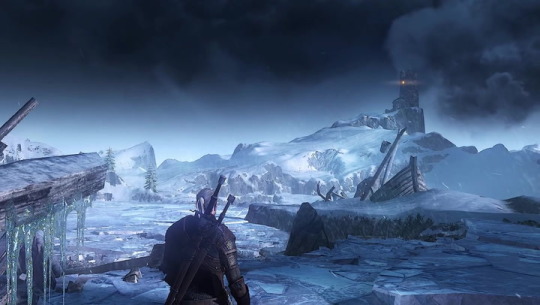
The treatment of the White Frost is even more confusing. The books are ultimately fairly explicit about just what the White Frost is: a ice age, most likely caused by the same mundane climactic factors that produced the real ice ages of our history. The only escape is intergalactic emigration, as Ciri (or her children) might some day enable.
In the games, the White Frost has instead become some sort of nebulous, free-floating apocalypse which will eventually reach all worlds, which is basically fine – up to a point. We briefly visit a dead world that the Frost has decimated, and even the Aen Elle are now supposedly planning to invade Ciri's world because it threatens theirs as well (I mean, apparently – their motivations are so underdeveloped you could miss them by accidently skipping just one or two lines of dialogue). When the Wild Hunt appears, it's always in a haze of cold. Their mages can invoke its power still more dramatically through portals which can freeze you in your tracks. So obviously, the Frost has already reached their world, and time is running out, right?
Well, no – you visit their world too (again, briefly – to meet a character who has never been mentioned before and won't be again, for reasons which have also never been mentioned before if you haven't read the books) – and there's no Frost in sight, apocalyptic or otherwise.
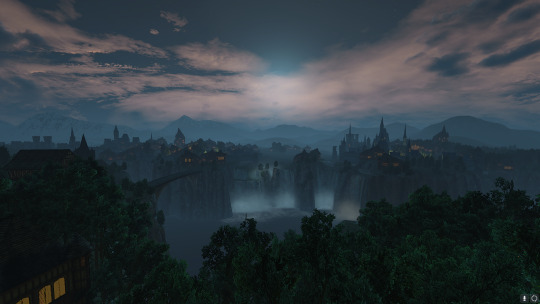
So why does the White Frost follow the Hunt around? No idea. It's never explained.
At the very end of the game, a second "Conjunction of the Spheres" occurs (possibly because of the Wild Hunt's appearance?), and the Frost begins to invade (or possibly Avallac’h summons it, so Ciri can go into it and destroy it?) It's all painfully unclear. The game is too busy pulling a bait-and-switch over whether Avallac’h's betrayed you to tell you what's actually going on instead.
But if Ciri could destroy the Frost completely (at great personal risk, but still) why is this not more clearly set up? Why did the Aen Elle think that escaping to another world (which will ALSO eventually be destroyed by the Frost) was a better solution than sending Ciri to face the Frost directly? For which matter, why do the Aen Elle need Ciri at all if sending enough ships to carry an army is no problem? Why does Ciri spend so much of the game questioning Avallac’h's true intentions, if they were ultimately so noble? When did he tell her the truth? If Avallac’h did summon the Frost, why did he pick that particular moment? And if he didn't, and it all just happened spontaneously, we're back to questioning why invading that world ever seemed like a good solution to Eredin – it all collapses in on itself.
None of these questions couldn't have been answered with a little creativity, but then the game would've had to dedicate some real time to explaining its backstory and developing its core conflict – something it's bizarrely reluctant to do. And if you think I may be drifting from the point a bit in the name of getting all my gripes about the ending down in one place, you're not wrong, but I feel Avallac’h and everything surrounding him is pretty much the ur-example of what doesn't work about the way The Witcher 3 depends on the novels: the backstory the writers are building on doesn't actually exist in any format available to the rest of us.
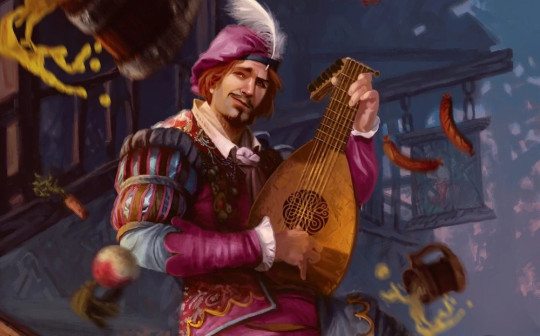
There are plenty of ways TW3 could have incorporated its backstory into its own narrative (yes, even excluding the method "by expecting people to read many many more pages of text from in-game documents", because that's bullshit and always will be). There are times it does this brilliantly, such as in the quest ‘The Last Wish’: everything you really need to know is covered in Yennefer and Geralt's conversation in the boat, and without ever making the dialogue sound unnatural. In fact, TW3 has even more options here than many works with the same problem, because Geralt is famous and people already think they know his story. You could have bards singing Dandelion's ballads, you could have characters confronting him with misunderstandings about his past to force him to correct them. You could also have Geralt visiting people and places he knows Ciri remembers fondly because of the time they spent there together, or include playable flashbacks similar to the time you spend playing as Ciri. You could stick chunks of backstory in optional sidequests or scenes old-school fans can skip through quickly. So many of my questions (how did Ciri get so close to Yennefer if they were never at Kaer Morhen together? Why has no-one tried training Ciri in her powers before? What does the Wild Hunt even do while it's not hunting Ciri? Why is Ciri princess of Cintra if her father is Emperor of another country altogether?) could have been answered so easily.
Seriously, summarising the Witcher books is not that hard. Lots of things happen, but only a fraction of it is really relevant in retrospect, and you could hit all the major plot beats in a handful of paragraphs. (Heck, I’d do it here if this post wasn’t already ridiculously over long.)
But then, TW3 has a bizarre problem with leaving so much of its best material off screen, even from its own story. It's criminal that we never get to see any of Geralt's time (or Yennefer's) with the Wild Hunt, even in flashback or dream sequence. This is material that directly sets up the relationship between the main hero and the main villain, and the most we ever hear about it is a few vague allusions to it being like a strange nightmare. Really? That's it? What was it like? Was Geralt in a trance, unable to control his own actions – was he brainwashed into believing he belonged there, or was he merely unable to escape? What atrocities might Eredin have forced him to commit? Did he visit other worlds? Was he paraded among the Aen Elle as a captive? There is no way this isn’t a part of the story worth talking about!
We never see the moment Ciri rescues Geralt from the Wild Hunt. We never see how Avallac’h convinces her to trust him, we never see the moment he was cursed, or any of her efforts to save him – all these big, story-defining moments are left off-screen, to be vaguely recounted to you later in dialogue. Then there's the entire political situation in Nilfgaard – you hear about it second-hand, and it's all resolved off screen. And the list goes on. Yet you and Ciri still have time to run around Novigrad so she can thank a bunch of throwaway characters you've never even heard of before, nor will again. The priorities on display here are baffling.
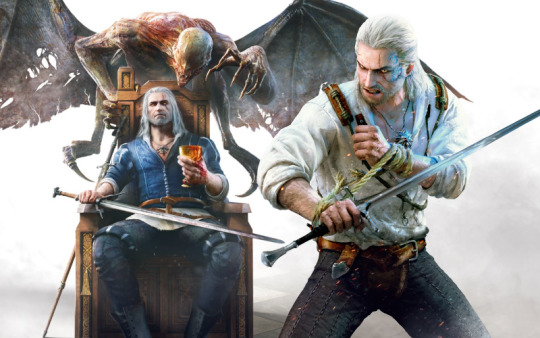
The Witcher 3 was such a wildly successful game that it’s obvious these sorts of issues didn’t seriously hold it back, and it’s such a big game that I could have sat down and written just as many words focusing only on the parts that do work without much difficulty. It boasts stunning visuals, addictive gameplay and some truly wonderful characters, and so many parts of the story work brilliantly in isolation that it’s strange to come out of it feeling that it ultimately adds up to so much less than the sum of its parts.
I’m glad TW3 exists – if it hadn’t been such a runaway success I doubt I’d ever have discovered Sapkowski’s universe at all, but for myself, TW3 will probably always be remembered as a somewhat-overlong introduction to the really good stuff, in the expansions and the original novels it came from. I looked up the novels after finishing TW3 in large part because I’d been left with so many unanswered questions – and I’m glad I did, but I’m honestly surprised more people weren’t turned off by TW3′s scattershot approach to its own narrative. You’re allowed to change and rework in moving to a new medium, but I can’t imagine it would’ve hurt games’ success to tell a complete story in the process.
101 notes
·
View notes
Text
Plotting Method #7: Stream of Consciousness
Okay. Full disclosure. This is how I plot, and it’s a mess--but a lot of fun, in my opinion; and if you have a lot of thoughts all at once that aren’t necessarily coming out in a logical order, it may be the method for you.
This method doesn’t really have coherent steps, because it’s just based on the natural flow of your own thoughts.
Where to Start
Start with whatever you have. For the examples here, I’m going to make something up as a I go along, exactly as I would if I were doing this in real life.
Maybe you have an idea for a character, or a scene, or a concept. Start there by just writing it down. I write it as if I’m talking to myself, in full sentences, but may you’ll do bullet points, or a mind map, or some other method.
EXAMPLE: “Story idea: a story where a guy is on the run from death. Death is looking for him for some reason, and he’s trying not to be found.”
Expanding Upon the Idea
Okay, so now you have... something. And you don’t really know where to go with it. So start asking yourself questions, and try to answer them. They don’t have to be good answers, and you don’t have to use any of what you write. You’re just brainstorming until something clicks.
EXAMPLE: “So why is death after him??? Maybe he was supposed to die but found a way not to? May he was sick, knew he was dying, and somehow found a way to hide from Death (who is like an actual being in this world). Or maybe he died in some accident and made a deal with Death to get a little more time, and now Death is here to collect after the time runs out, but in the meantime the guy has found out a way to hide from Death? I think I like the first idea better though.”
Bouncing Around
One thing that is nice about this method is that you don’t need to work chronologically. You can bounce around as ideas come to you, and then go back and rework what you’ve come up with so far to fit in with the new ideas.
EXAMPLES: “I have this image in my head of a scene where the guy has finally been caught by Death, and is standing in like this... in-between, limbo world or something. Death is all pleased he’s finally caught up with the guy, but then the guy whips out this item, like a coin, that buys his way out of death. And maybe that’s how he does it, there are these special coins that can “buy” your freedom from death, and he has some way of finding them, over and over again, and always has at least one when Death shows up to collect the next time. And maybe he keeps dying over and over again in ridiculous ways, like eagles dropping turtles on his head and having sinkholes open up under his feet, as Death keeps trying to take him by surprise.”
Give Yourself a Goal
Once you have something to work off, start asking yourself questions about the conflict, climax, character goals, etc etc. Start working on getting your plot some direction, goals, and structure.
EXAMPLE: “So I know the conflict is this guy running from and outwitting Death, but what’s the climax? Where does that lead? Maybe he has to work WITH Death for some reason? Maybe he meets someone who needs to die by the end of the story? I feel like I want the main character to have to die in the end, but he has accepted it, and is ready to let it happen. Oh, maybe he meets someone who is going to die for some untimely reason, like they weren’t supposed to, and he has to give that person his coin to save them? Like, maybe he meets this woman, and while he’s in Limbo with Death, handing over his coin and getting out of dying for the millionth time, Death suddenly feels... like, a disturbance in the force. Something has happened that wasn’t supposed to, someone’s fate has been changed. Maybe Death pulls out this hourglass and sees that someone’s hourglass has suddenly lost a huge amount of sand at once--not supposed to happen. Death go,es there, bring MC for some reason? MC meets the woman, maybe she’s a Queen or leader of a group or country, and someone is planning to assassinate her. Death has a lot of work to do obviously, but can’t have this kind of reality-altering nonsense going on, so partly out of spite, he tells the MC to fix whatever has gone wrong and protect this woman, and he (Death) will stop trying to kill MC all the time. So then it becomes this political intrigue thing.”
Inevitable Changes
Do you see what happened up there in my example? Originally, I’d started out with an idea that the main conflict was between the Main Character (MC) and Death, and that the main antagonist was, more or less, Death. But now I have this completely different main antagonist, some shadowy assassin, and Death and my MC are forced to become allies. Things change as you work and come up with new ideas--and sometimes, you might follow a thread of an idea to the end, and find out it doesn’t work after all. You may have to throw it out and start over, possibly more than once. But it also helps you avoid plot holes later, by working through them in the planning stages.
Keeping Track of it All
The biggest challenge with this method is ending up with twenty pages of rambling plot, half of which you changed or didn’t use or is just you asking yourself questions.
How I combat this is by liberal use of my word processor’s highlighter. Once I feel like I’ve hit on something I’ll use, I’ll highlight it in the document, usually according to some kind of color-coded system (e.g. yellow for plot points, orange for actual scene ideas, blue for character ideas/background/development, green for lines of dialogue I’ve just thought of, etc).
Then, once I’ve plotted out as much as I can, I’ll go back through the document, pull those highlighted bits, and put them all in their own document--et viola, I have an outline.
The beauty of this method is it allows you to plot as minimally or extensively as you like. You can use it just to get a general sense of your overall plot, or keep drilling down until you end up with a chapter-by-chapter outline.
________________________________________________________________
If more structured plotting methods feel too restrictive or cookie-cutter, this could be a good alternative. If you’re transitioning from pantser to planner, it could be a good method to ease yourself into the new writing style. If you struggle with writing yourself into plot holes, this method could allow you to pursue plot threads in more depth before you write them, allowing you to spot pitfalls earlier on and avoid them later. Or if you find yourself just coming up with too many ideas all at once and struggle to get the first ones written down without forgetting the later ones, this method could allow you to just get all those ideas down and worry about stringing them together later.
#story plotting#plot ideas#plot#plot methods#plotting methods#writing tips#writing ideas#story structure#how to plot a story
92 notes
·
View notes
Text
Coming Attractions!
A day late, but ah well...
As usual, we’ll go ahead and do an Open Question Night. Which basically means that, while my ask box is always open, tonight I’ll be keeping an eye on it and answering things as they come in. Any fandom or work I’ve talked about here (or posted on AO3) is fair game, as are general questions about writing, etc. I do accept prompts, but I am. Not very good at filling them in a timely manner unless they Immediately spark something, lol.
So, yeah, what’s on your mind?
Also, since I don’t think I have for a couple months, plug for my Discord server! It’s pretty quiet, mostly intended to be a slightly more interactive extension of this space, but you’re welcome to check it out!
Anyway, the usual Coming Attractions details are behind the cut!
PodTogether 2021:
I participated in this challenge for the first time this year, and it was a whole lot of fun! Of Other Suns is a SW/AtLA crossover, and I think it turned out pretty well! My reader/podficcer and I worked pretty closely together during the initial brainstorming process, working out what we wanted to do, and also bounced off one another during the whole editing/finalizing process. There’s a lot that I didn’t end up putting into the fic (because time and length; I am a. Uh. Very wordy writer; the aim was for 6-12k words, we ended up with nearly 15k as it is...), so I might poke more at this specific AU, or crossovers linking up at a different time (either a different point in the SW canon, or in the AtLA canon, or both). I...definitely have extensive headcanons for SW characters as benders of various elements (or nonbenders), and there are at least two Force-sensitive AtLA characters who were outside the scope of the crossover.
Anyway, if you want to check it out...click this link XD (and definitely listen to the podfic too!!! It’s really great)
Precipice:
So, between the final push on PodTogether and some origfic stuff I got done, I...did not get anything finished and posted for this, alas. But! I am saying it here in the hopes that doing so publicly will for once get me to actually stick to a deadline, which is that I will get either the first Protectors chapter or the next Preludes one-shot (or both!) up by this Sunday, September 12. The Protectors chapter will be mostly scene-setting, establishing where various characters are when we open, six years after we last saw our heroes. The Preludes segment will involved Hondo contacting Obi-Wan (and Anakin, who’s with him when he gets the call) about something Relevant To Their Interests.
I will for sure get that Prelude out this month, and hopefully at least two Protectors chapters, but we’ll see how things go at work and how much brain that takes, which is always a factor...anyway, with any luck, I’ll start establishing a Rhythm. I don’t think I’ll be doing weekly updates, the way I did for the first few arcs of Precipice (in part because there are some other longform projects I intend to start putting out and if I am going to do Weekly Fic Posts, I’ll probably alternate), but we’ll see how things go.
AtLA Fic:
Again, I didn’t finish what I wanted to (other than the aforementioned crossover for PodTogether), but I have been working on stuff in the background and, while I’m not going to commit to a Specific Deadline like I am for Precipice, I do plan to post at least the opening chapter of the still-untitled Avatar Zuko AU I’ve been working on this month, so watch this space!
Other Fic Projects:
I’m poking around at what to do for next years SWBB (if only because my wordcounts have been Steadily Increasing and I’d like to get a head start in anticipation of that happening again this year, lol). Still considering exactly what to do, whether I pour all my focus into OFLAM, like I consider every year, or see if I can work up Bail Unfucks the Timeline or another half-plotted AU I have in the back of my head, or go with a different prompt/storyline that occurs to me at some point between now and then, but I’m starting to Actively Ponder things.
I do have that BSG1 crossover outline in the works, I swear XD I’ve got...uh...maybe half to two thirds of the first third of the overall storyline written up? XD It’s a. Uh. Long one. I might go ahead and release it in three parts, just for length/convenience, and because it does more or less have three distinct sections (the initial contact/New Caprica fallout and establishment of the Haven settlement which makes sense in context; the second contact/algae planet; and then an adventure on a resurrection ship to retrieve a Specific Boxed Five and possibly walk away with Ellen because that would just ruin Cavil’s day and I do so love to ruin Cavil’s day, lol). ...I’m going to go ahead and post a preview snippet at the bottom of this post, as Motivation XD
I think that’s all the fanfic stuff I have specific updates for. There’s generally always stuff noodling around in my brain (lately, for Star Wars, AtLA, BSG, or some combination of the three), it’s just how much of it materializes, lol.
At some point, I plan to revisit some BSG epics I had going on (Serenissima; rewriting For Sorrow Sung or doing a slightly different storlyine with the same concept; The Other Battlestar; a few others), but no concrete plans as of yet.
I also kind of want to explore a far-past AtLA setting I designed for a challenge community way back? But I’m not sure if that would work better as an original work with the serial numbers filed off, if I could figure out how I wanted to do that (I have done it before, as I’ll talk about below, but this concept, while not directly involving any characters from Avatar canon as it’s set 2000 years prior to Sozin’s reign, does to an extent lean on the Avatar specifically as a concept, in a way that the other fic I did this with did not).
Original Fic:
Due to a challenge on rainbowfic, I actually got. Quite a bit written? Most of it was not super plot-relevant, but I dropped some Hints about a character in Lux and I got to play in some heads I don’t very often. I might go back to the Regency AU at some point, and there’s a specific reveal I want to write up for a secondary character in The Farglass Cycle, but I haven’t quite figured out how to structure that one, so we’ll see how it goes.
Had an interesting discussion the other day about the way original fiction sometimes starts as fanfic with the serial numbers filed off and...well, a lot of my original stuff starts that way? Or has some roots there, anyway.
Lux doesn’t quite as much, but I definitely ported in at least two characters who started as fanfic characters (leaving aside that this is, y’know, The Apocalypse IN SPACE so, like. Various fandoms that deal with that probably influenced things, plus several key players are Public Domain Characters sooooo), plus some of the way the world is constructed draws on the Native Tongue trilogy and I flat-out stole a concept from Queen of the Damned, though the way it works in this world is different (also, to be fair, I think I’ve seen it in other places, too; but I personally got the idea from there).
The Farglass Cycle and Untitled Intrigues Story, however, straight-up started as fanfic concepts. And I don’t think it’s obvious unless I point out what the source materials were? Farglass, in particular (it’s the AtLA fic I mentioned earlier), because it started as an alternate future and then the map and magic system got reworked, plus the Avatar themself wasn’t even super involved in the original fic context, and while certain characters are very loosely based on AtLA characters, by now they’ve been so altered by the setting that it’s...I used the same archetypes, if that makes sense?
And then Untitled Intrigues Story started as a fusion between two wildly different fandoms, and while one character is a pretty clear expy if you know where he comes from, and another character kept the same actress in my head, I don’t think it’s very clear other than that.
...anyway, not sure where I’m going with that, other than it’s been in my head lately, lol.
...I think that about covers it! What about you guys? What are you all working on? Slash any questions, etc.?
Teaser for BSG1 AU outline, as promised:
So, anyway, SG-1 is prepared for rain and mud and a survivable-but-kinda-unpleasant environment. They’re also prepared for the usual shenanigans--Goa’uld, cranky local politics, weird alien tech that Daniel really should know better than to touch but sends him into another dimension anyway...
Just. Y’know. A normal mission.
They’re...not quite prepared for what they actually find when they step through.
Which is a very tense and now slightly Confused crowd of people, and a firing squad made up of very large killer robots, with a teenage girl as their target.
(One of the large killer robots is. Uh. Well. Half a large killer robot now; that particular Centurion was in the wrong place at the wrong time and got kawooshed in the face. As one does.)
(Said Centurion absolutely wins the ‘Weirdest Death’ pool for the week in Download City, because that is clearly a thing that exists because it entertains me)
There’s a beat where everyone just stares at everyone else, trying to figure out what the hell is going on.
The wormhole disengages.
Daniel takes half a step forward, opens his mouth to start the ‘we are peaceful explorers from Earth and y’all seem to be having a Moment here, sorry for interrupting, but, uh...’
And then the moment end and absolute chaos erupts.
#coming attractions#open question night#shadowsong writes star wars#shadowsong writes atla#shadowsong writes crossovers#shadowsong writes original fic#feedback greatly appreciated
2 notes
·
View notes
Text
Shang-Chi and the Legend of the Ten Rings
As some may know, I managed to stumble upon the world premiere for Shang-Chi and the Legend of The Ten Rings when visiting Hollywood Boulevard for the first time. A month later, I can finally confirm that the movie, while deeply flawed, is still a lot of good fun!
~~Mild plot spoilers entail ~~
Shang-Chi is yet another origin story, centering around a highly trained heir (and escapee) of the Ten Rings, the very same Chinese terrorist organization/criminal empire/ancient cult that inspired the terrorists that captured Iron Man. What entails is the title character’s journey to escape his father’s machinations while exploring his mysterious mother’s family history, all the while beating up (or getting beaten up by) nearly everyone along the way.
Like all the superhero films made by the house of mouse, Shang-Chi is just as formulaic as you’d expect. While I saw it in 2D, Disney’s generic structure for its MCU line sure as hell popped out of the screen. There are multiple scenes that feel directly ripped off from Black Widow and Black Panther, if not other MCU movies that haven’t come to mind. Car chase that alludes to the main villain? Check. Slowed down second act where more backstory and pathos is unraveled? Check. Final battle that overdoes it with ugly CGI? Check. It really feels like Disney just chooses between the same 2 or 3 storyboard plot structures for all of the 25 films they’ve released.
With that in mind, I think the fact that this film is just pure fun heavily distracts from its formulaic nature. The main highlight is its action, where, unlike Black Widow, Shang-Chi actually fulfills my hopes for this area. Much of this is due to its phenomenal kung-fu fight choreography and wuxia stylings, which really raise the bar for action and fight choreography in the MCU. As my fellow theatergoer put it: “They could’ve had fights like this in Black Panther but didn’t??” and I agree, the rest of the MCU pales in comparison. Shang-Chi in general feels like a MCU movie able to embrace the fun and comic booky nature of its source material, something that Iron Fist, the previous MCU kung fu adaptation completely failed the mark on. When it touches on MCU synergy it feels original and believable, rather than the “Tony Stark is singlehandedly involved in every villain’s backstory” formula. Additionally, Shang-Chi distinguishes itself from other Disney Marvel products in that its humor actually feels organic rather than tacked on, not disrupting any important moments. While leads Simu Liu and Awkwafina aren’t the most charismatic or convincing actors at times, they make up for it by absolutely nailing every punchline that comes up.
Speaking of acting, one of the biggest pulls to this film was the casting of acclaimed Hong Kong actor Tony Leung as its villain. While he delivers a solid performance as the main villain, Wenwu, I couldn’t help but notice how strange and contradictory his characterization felt, which kind of messed with the tone for me. In the early exposition, he’s set up as a devious thousand-year warlord, but when he finally appears in the present the film immediately starts portraying him as a very laid back albeit manipulative goofy dad that literally wears dad sandals to his evil schemes. While fleshing out a villain and giving him pathos is generally admirable, I think doing so heavily disrupted the stakes, tension, and comic book-y fun of the film. It’s always possible for a villain to have some type of compelling motivation while still being dastardly evil, or at the very least acting like a real antagonist. Instead, we get someone that fully sounds evil on paper but in practice is more of an important side character that the protagonist happens to disagree with. While this can easily be attributed to Disney’s poor writing and handling of its characters, they’ve already managed to solve this problem and do a far better job of balancing “evil” and “compelling” with villains such as The Vulture and Killmonger. I’m sure a good amount of people are fine with this, especially since Wenwu is in fact a combination of multiple racial stereotype villains and this could be seen as a complete reworking of the characters, but with this in mind I’d still prefer someone who’s a teensy bit more war criminal than wife guy.
As previously mentioned, the costume design was another disappointing point of this film and one of the few parts (other than Wenwu’s character) of the movie that didn’t fully indulge in comic book-y excess. Wenwu is a combination of a Bond villain and an evil wizard but sure as hell doesn’t dress like one, instead wearing hilariously drab suits or just a button up, and even his outfit in the final battle is an ugly and subdued black leather getup that looks more like he’s leading a swat team than an ancient organization composed of the greatest martial artists on earth. This lack of vision extends to the rest of the costumes too, as before the final battle the main characters are presented with “clothes were made out of dragon scales for special protection” like no dude they look like they were made out of plastic and rubber. Aside from the Disney+ shows, costume design has always been the MCU’s weakest link but I will continue to roast them until they decide to make something that doesn’t look like trash.
Shang-Chi feels like a far better return of the MCU to the big screen, but still has a few things that drag it down for me. I’m thinking I’ll give it a 7.2/10
1 note
·
View note
Note
so i recognize that this is. a lot. but,,,, 6, 8, 14, 22, 25, 28, 33, 35, 37, 50, 55, 60, 63, 66, 69, 77, 86, 91, 104, and 122? :)
0_0
Oh thank you, this is a gift
Okay, here we go!
6 (a book with a pink cover) : I'm gonna cheat a bit because only part of the cover is pink but Wild Beauty by Anna Marie McLemore is one of my FAVORITE books, so I don't mind bending the rules. Five bisexual latina cousins all crushing on the same girl, magical realism, and a very good application of social messaging to the themes. I won't say more than that, but really go give it a look!! also my copy is signed Viva México by the author so that makes me love it more
8 (a book you finished in one sitting) : Okay, a couple years ago when Tiamat's Wrath by James S. A. Corey (book 8 of the Expanse series) came out, I started reading it at breakfast in the dining hall, continued during basically all of my classes, and then finished it sometime around 10 or 11 that night (I think). For reference, a quick google tells me that book is about 166,500 words. And I loved EVERY minute of it!
14 (a book that made you trip on literary acid) : Okay, that has definitely got to be Harrow the Ninth by Tamsyn Muir. Just. All Of It. God, she does some really fantastic things with narrative mechanics in that book, plus just the sheer brilliance of the plot and the mountain of questions and theories I had once I finished it. Also the memes. The memes made me trip literary acid.
22 (your favorite thriller) : Okay, I think I've literally only read one thriller (if it counts, I'm not sure), but The Ninth House by Leigh Bardugo. I'm cheating since it's still fantasy, but I had a limited pool of options.
25 (a book by your favorite author) : Okay, so I tend to like books or series more than author's specifically easier to like a work of fiction than a person but I'm gonna go with The Hobbit by J.R.R Tolkien. I grew up reading his books and I've definitely taken a lot from his writing for my own style, and I still love the Hobbit.
28 (a book you wish you could read as a beginner again) : Oooh this is a really interesting one. I think I'd say Museum of Thieves by Lian Tanner. I can’t remember when I first read it but it’s a middle grade story all about defying authority and escaping corrupt systems. I really need to reread it at some point.
33 (a book with a white cover) : The Weight of Feathers by Anna Marie McLemore! (can you tell I like their writing?). Star crossed lovers of two performing families with magical realism threaded through the narrative! Really fun read and I always appreciate latine characters. There's also Roma representation as well!
35 (a book featuring the found family trope) : I'm gonna attempt to not read any well beaten paths, so I'll say Caliban's War by James S. A. Corey, the second book of the Expanse series (okay that's technically a well beaten path, sue me). A lot of the book is the main characters figuring out their group dynamic and challenging each other to be better and it's just so goooooood!
37 (your favorite heist book) : I mean, what else could I put here? Crooked Kingdom by Leigh Bardugo, hands down. Narrowly beats out Six of Crows, only because it has more cons, more emotions, and also Nikolai Lantsov. I'll never get tired of that book.
50 (a book that made you cry a lot) : oh boy, I could say Crooked Kingdom again, that’d be true. But instead I’ll say Persepolis Rising by James S.A. Corey (I read a lot of series, sue me. Also that series is gonna be 9 books long by the end, there’s a lot of material). Anyway I won’t say why I cried, it’s a spoiler, but oh man. I weeped.
55 (a book with a satisfying ending) : The Empire of Gold by S.A. Chakraborty! I really liked how it ended, it placed a lot of focus on the platonic relationships, it left a lot of plot open ended so it felt like the world was still alive, and it showed the main character as being in a position of power while still retaining the subversive and roguish qualities from the start of the series that I loved.
60 (a book that you think about at 3am) : The Empire of Bones by N.D. Wilson. This is the 3rd book in my favorite series, the Ashtown burials and just….. wow there is so much. It has so much depth to it while still being about a 13 year old standing up to a cadre of ancient death and pain gods. It has one of the most beautiful monologues I’ve ever read and that shaped my understanding of compassion and heroism. It has an orange mohakwed Irish monk.
63 (a book that actually made you laugh out loud) : I knew it would make it on the list somewhere but GIDEON THE NINTH BY TAMSYN MUIR. God this book was funny! I won’t spoil any of the jokes, but Gideon is a sarcastic little shit and I love all of her banter with Harrow and the rest of the characters get plenty of cracks in as well.
66 (a book that fucked you up) : oh boy The Lies of Locke Lamora by Scott Lynch. This book had some visceral shit in it. Like, not exactly in a bad way, its not a game of thrones situation, but stuff that made my fucking skin crawl. Very good book, I heartily recommend.
69 (your favorite mythological retelling) : I’m gonna go with Odd and the Frost Giants by Neil Gaiman. I first listened to it in audiobook form while on a road trip through the southwest and I really like coming back to it. Sort of reworks the original myth it borrows from, but in a really delightful and fun way.
77 (a book so useless you could use it as a coaster) : ATLAS SHRUGGED BY AYN RAND. Alright, I’ll be honest, I have not yet read this book. I probably will someday just to see how bad it really is. But from what I know about it I would rather get drop kicked off a roof than read that pile of self important, self centered ego circle jerking. In conclusion, I don’t like it.
86 (a book with an insane plot twist) : Okay a bunch of the really insane plot twisty ones I’ve already mentioned and I don’t want to do repeats, so I’m gonna bend the rules and say The Silent Bells by N.D. Wilson, fourth book of the Ashtown Burials series, a book that is not technically finished yet, it is being released serially in this really cool faux newspaper format. The plot twist is that this story ever got off the ground, because due to legal and publisher shenanigans the author wasn’t able to publish the book until 7 or 8 years after the last book came out. But he did! And I’m very happy!
91 (the shortest book you've read) : That would probably be Signs Preceding the End of the World by Yuri Herrera, translated by Lisa Dillman. It’s a really good book I read for an English class about a girl who crosses the US/Mexico border in search of her brother. It’s got a really interesting narrative style that I wasn’t used to and a really cool thematic structure related to the nahuatl journey to the underworld.
104 (a fluffy sweet read) : oh man, that’s tough, I don’t read a lot of fluffy things, even tho it’s what I prefer in my romances. Yeah, the closest I can get is Wild Beauty by Anna Marie McLemore again. (See the first question answered)
122 (your favorite winter read) : Hmmm I don’t necessarily have seasonal reads, but I’ll go with an old family classic The Christmas Mystery, which is about a boy who finds an advent calendar with little scraps of paper behind each door, telling the story of a little girl who in the process of chasing a lamb runs away to Bethlehem (and back in time) to the birth of Jesus, meeting angels and Shepards and other biblical figures. It’s a really sweet story and my family used to read each chapter every day of advent until Christmas Eve.
#COMPLETE#ho.ly.shit.#Jack thank you for that book workout#SNORT#that was an entire bookshelf#books#hope you like it!#long post
5 notes
·
View notes
Text
If We Can’t Have the Parties, At Least We Have the Coats: Lookbook no.13
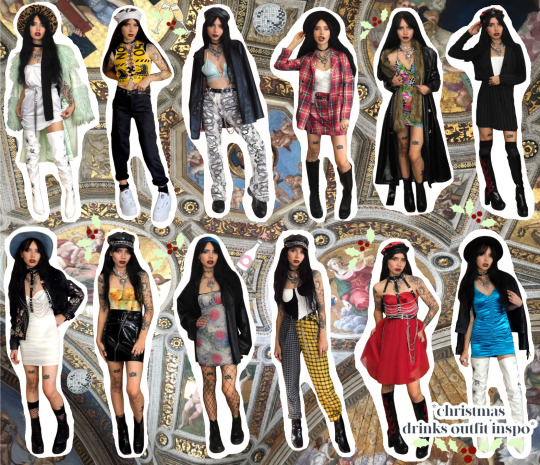

Hi to anyone reading,
It’s been a weird winter, right?
A winter that I REALLY did not need to buy as many clothes for as I have. You WILL save loads of money during this lockdown, I told myself. You WILL. And yet here I am in December, in exactly the same financial position I was in March. You would think that making the switch to an environmentally friendly wardrobe would mean I own less but now I no longer have the guilt of supporting fast fashion to hold me back, I’ve accumulated more clothes than ever. Part of a sustainable wardrobe is also about reducing your consumption so now I’ve mostly made the move towards only supporting transparent companies/small businesses, I can move onto the buying less part. I haven’t thrown any clothes away but still, I am not the clothes rescuer I think I am-more just an overdraft abuser. To add to that, for those of us actually following the rules (half the people I went to secondary school with flaunting their apparently unaffected social lives on Instagram, I’m looking at you) there aren’t actually all that many opportunities to wear new outfits. Not to go too first world problems, but it is a little shit when getting dressed up and doing your makeup is one of the things that you do to help you feel a little better, especially when the seasonal (and situational in these times) depression kicks in.
So yes, I have been extra af recently and combatted this with the decision to start making an effort to outfit plan for the most basic of tasks. We’re talking a full face of makeup and accessories for going into town to get a coffee or to meet a friend for a walk. I mean, I still go to Tesco in my trackies but if I’m seeing somebody else, I am sure as hell going to treat it as a reason to wear something nice. See the winter outfits section of the lookbook as your inspiration to do the same because I can guarantee you the sense of normality forcing yourself to take makeup off at the end of the day brings will actually make you feel a lot better. Genuinely the mark of exceptional times. We’ve also got the few days relief period over Christmas in the UK where we’re allowed to mix with a maximum of 3 other households, and ignoring the fact that it doesn’t really make any sense given that the number of people you could end up mixing with depends on the size of the households and is realistically completely arbitrary (I have a lot of feelings about how fucking moronic half the decisions this government has been making are but then again, what’s new?), I’m sure those of you with big families are gonna be partying. I’m only spending Christmas with my immediate family but I thought I’d put some more festive outfits together anyway. I know, I know, it sounds like I’m just bullshitting an explanation as to why I put this lookbook together when in reality I’m trying to make myself feel better about the damage to my bank account buuuut it really is more a case of being inspired by my Depop finds and if you are trying to quit fast fashion, I can’t recommend the app enough (especially if you know what you’re looking for). As I did in the last lookbook, I will make sure to include the tags of all the people I bought these pieces from but I also thought it might be helpful to make a note of some of the descriptors I used to find them so you can get more of an idea how to find the things you’re looking for too, as well as prices. I did include the names of the shops I bought the few fast fashion items I styled from too, mostly earlier this year or at some point over the last couple of years, on the basis that they may be a useful search prompt if you’re looking for something similar or the exact item-the majority are no longer available (disclaimer: I haven’t bought anything from Boohoo in a longgg time) to buy but you might be able to find an account that’s selling a used version. Don’t be put off by that-I’ve had to wash a couple of pieces but for the most part, that hasn’t been necessary. Charity shops usually wash things before they put them out, so you have nothing to worry about there either-I expect that they’re particularly thorough at the moment considering the COVID crisis.
Enough rambling from me for now! Enjoy!
-(SOCIALLY DISTANCED) PARTY SZN LOOKS-

Powder Blue Wide Brim Felt Hat/Fedora: £16.99
Structured White Mesh Oh Polly Mini Dress w/Ruched Detail: £27
Black PVC Beret w/Red Flame Detail: £14
Red Fit and Flare Dress w/Satin Corset & Tulle Skirt: £12
Black PVC Vintage Platform Boots w/Red Flame Detail: £27

White Satin Corset w/Straps: £8
Pinstripe Cropped Blazer Co-ord Set: £12.50
Oh Mighty Strappy Contrast Corset: £27
Contrast Check Cigarette Trousers: £15

Pink Topshop Gingham Blazer Co-ord Set BNWT: £35
White Strappy Corset w/Suspender Detail: £10
White PVC Beret w/Black Flame Detail: £14
Reworked Strappy Patchwork Sports Cropped Tee: £10
Black Combat Cargo Trousers: £5
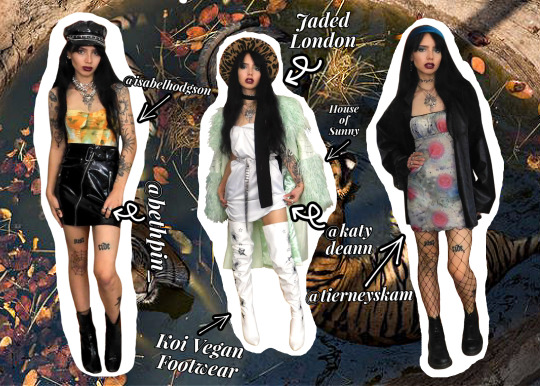
Strappy Tie-dye Pretty Little Thing Corset BNWT: £15
PVC/Vinyl Zip-up Mini Skirt w/Belt Detail: £9
White Satin Cowl Neck Mini Slip Dress: £8
Urban Outfitters ‘90s Style Celestial Print Mesh Babydoll Dress: £15
-(SOMETIMES PRACTICAL) COAT SZN LOOKS-

UNIF Colour Block Oversized Jumper/Sweater: £25
Topshop Dark Wash Denim Kick Flare Jeans w/Frayed Hem Detail: £16

Vintage ‘70s Style Brown Faux Suede Western Blazer/Jacket: £15
Black Velvet High Neck Bodysuit w/Keyhole Detail: £4
Topshop Paisley Print Chiffon Midi Dress: £15

Brandy Melville Cropped Motorcross Slogan Slogan Tee: £13.60
Ragged Priest Gingham Cargo/Combat Trousers w/Utility Style Buckle Detailing: £33
Black Kappa Logo Beanie: £12
White Platform FILA Disruptors in Good Condition: £55
Black Fur Bucket Hat: £8
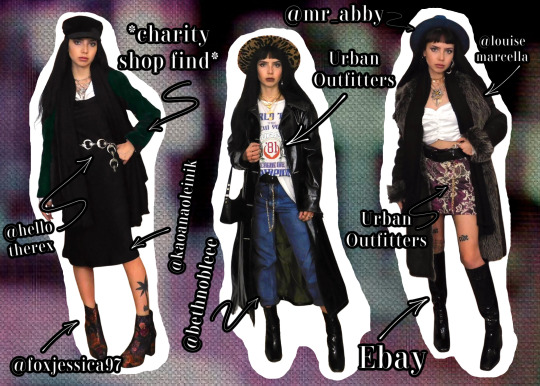
Celestial Silver Moon Detail Chain Belt: £18
Black Satin Cowl Neck Detail Midi Slip Dress: £15
Floral Print Platform Boots: £10
Blue Denim ASOS High Rise Mom Jeans: £12
Brown Vintage ‘70s Style Afghan Coat w/Fur Trim: £25
Teal Wide Brim Felt Hat/Fedora: £10

Topshop Floral Print A-Line Jacquard Mini Skirt: £7
Lana Del Rey Screen Printed T-Shirt: £9.99
Vintage Corduroy Contrast Stripe Trousers w/Kick Flare: £28
Anyone that read to the end, thank you so much as always and I hope this shows just how many in-trend pieces you can find second hand! I know I'm SUPER far behind to the point where it’s closer to the F/W2021 shows now than it is since the S/S2021 collections were showcased but I decided I am going to do a full length fashion week review. I also have a few moodboards planned and my next is gonna be one focussing purely on plus sized fashion as the feedback that I got from my New Style Icons post was that I could have included more bigger girls; I am so, so, SO passionate about body positivity and fat acceptance, especially since I know my own relationship with my body would be so much better if this kind of movement was more prominent when I was younger, so I don’t for a minute want anyone to think it was my intention to be exclusionary in any way. It bears repeating that I genuinely appreciate feedback in any form (as long as it’s not too mean and presumptive, lol) and I hope the next post doesn’t disappoint! It hasn’t been a good year for cinema due to COVID having lead to theatre closures, however I still do want to do another film tier ranking in the new year as that is something I really enjoyed doing last time. Any more suggestions are welcome!
As always, my inbox is always open if you need someone to talk to or just wanna chat about a post:-) I am constantly on the look out for new blogs to follow and people to interact with so any communication is welcome. I’m not sure if I’ll get another post finished before we enter 2021, SO I wanna say that I hope everyone has a wonderful Christmas and that this shitshow of a year DOES come to an end at 11:59PM on the 31st because THOSE MEMES ABOUT IT TURNING DECEMBER THE 32ND ARE NOT FUNNY! Here’s to our second attempt at our first year of the roaring twenties (because this past year it feels like we skipped them and went straight to The Great Depression, the likely incoming recession denial is real) and to happier times and good health for everyone.
Lauren x
DISCLAIMER: Background in the first 2 images are mine, others are not. I found them on Pinterest so not sure of the artists but if you do know, drop me a message so I can credit them!
#lookbook#outfit of the week#outfit of the day#ootd#fashion#style#fashion inspo#fashion blogger#style inspo#sustainability#sustainable fashion#depop#clothes#grunge style#grunge aesthetic#winter#winter fashion#cosy#alt#aesthetics#vintage#vintage style#70s#y2k#90s
7 notes
·
View notes
Text
A Vulgar First Impression of Coromon
Playing Pokémon games recently has been something akin to hiring a fairy princess to perform for your daughter’s birthday parties. The first few times she came around were fun, she made all the kids laugh and play their games, but now the princess has grown lazy, idly watching YouTube while disinterestedly mumbling the same four or five lines she’s been spouting for the past twenty-three years. But you keep hiring her regardless, even though your daughter’s trying to point out that she’s not into princesses anymore because she’s pushing 30, and you’re starting to think she might not be worth three hundred bucks a visit. And she’s starting to smell.
So as the Pokémon community sits and waits for the Diamond and Pearl remakes, because what is Pokémon if not a prolonged exercise in nostalgia bait, some indie developers have been trying their hand at doing Pokémon, but properly this time. First came along TemTem, which was, “Like Pokémon but online”, and now there’s Coromon, which is “Like Pokémon” and that’s it.
I’ll admit, I was attracted to Coromon not because of any underlying nostalgia or a want to replay Pokemon, but because the devs put out a free demo for the game, which is a rarity in this modern age of Early Access and delayed release dates. Intrigued, I decided to take a closer look, to see which warts they cut off and which ones they allowed to fester.
The game starts with our protagonist waking up in a small town with his mother about to go get his OR HER first Pokémon. So far, so standard. But where Coromon differs is that you aren’t some apple-cheeked youngster with a criminally neglectful parent, but a college kid who’s been selected for a prestigious university that studies Pokémon – sorry – “Coromon”. And incidentally, Pokémon scores the first point for having a name that actually means something. They’re monstrous creatures that can be caught in a ball and put in your pocket – “Pocket”-“Monsters”. What the fuck does Coromon mean? Because Coro only has a meaning if it’s in Italian, and I’m pretty sure these things aren’t meant to be called “Choir Monsters!”
Anyway, a dude in a wheelchair who was apparently the guy in charge gives you a magic glove and tells you about these glowing elemental orbs, which are important for some reason I wasn’t clear on, and he sends you out on a journey to collect more by finding six elemental titans and – as far as I understood the process – murdering them and stealing their essence in the name of science.
We choose our first Pokémon from a choice between the fire-type, the water-type or the… ice type? And then, we set out on our journey to fight trainers, make new friends, and shuffle about in the grass for an hour because your gobblefrog isn’t level sixty-two yet.
The first thing that struck me about Choirmon is that it really isn’t being coy with its desire to ape Pokémon. Everything, right down to the statistics of each monster, is identical to the way Pokémon does things. The types have the same names, evolving is still called evolving, it even gives you berries and other items for your monsters to hold. You can battle monsters in the wild, blundering into tall grass to scare them out of hiding and capturing them after beating them into a bloody pulp, or you can battle monsters owned by other trainers in unregulated dog fights. So it isn’t trying to be like Pokémon, it is Pokémon. It stabbed Pokémon in an alleyway, cut off its skin and is now swanning about performing a perverted Face/Off act.
Now, I love Pokémon just as much as the next guy, but I’m no deluded fanboy. Pokémon is not perfect. In fact, it’s a game with a lot of flaws. And in its desire to imitate, Collectamon inherits a lot of the same problems that Pokémon does. Using items, for example, takes up an entire turn, and while this can be forgiven in a party-based RPG, where you have other actors to make up for the guy losing a turn, you can only put out one monster at a time, and using anything other than a healing item in the thick of battle just makes you an open target.
Trying to think strategically is also a lost cause, because again, it’s fucking Pokémon. The only strategy is “use whatever the opponent is weak to” or “mash attack until one of you dies”. And while you could argue that Pokémon’s strong point is its simplicity, it does mean that winning a fight is more a matter of patience than a matter of skill.
At time of writing, I’ve been playing the demo for 7 hours. An impressive run-time for a demo, to be sure, and that’s only up to the first boss. Incidentally, it’s in that area that we meet the evil team of this game, because Pokémon had evil teams, and so must we! I don’t even understand their motivation, or who these people even are! They’re presented to us as if we already know what their deal is and why we should hate them. All I know about them is their name and the fact that they like to hang around in caves. Pitch-black ones that you navigate by wandering around aimlessly getting lost in the samey-looking environments.
Really, guys? You thought it’d be a good idea to preserve one of the shittiest areas in Pokémon? Actually, they follow it up with an even shittier level that plays like the gym leaders from the annoying puzzle gyms got together and tried to devise the most efficient backtracking machine, culminating in a game of Mastermind out of fucking nowhere.
Well, so far I’ve just been going on about how the game is the same as Pokémon. What’s different? Well, for a start, each monster has a well of stamina points that they spend to use their special abilities, limiting how many times you can use those moves before your monster has to have a little rest. So you have to weigh up whether or not you want to waste stamina using that really powerful move or whether you want to keep a steady pace with the weaker moves. Except, Pokémon already did that with each move having limited uses. So we haven’t gone anywhere. All we’ve done is paint the walls a different colour.
Erm… what else? Well, your character speaks for one thing, despite you being able to name them and customise them to your liking. I think we tried the talking player avatar thing back in Fallout 4, and it was just as unimmersive back then too. It means that you don’t really get to impose your own character on the avatar, because the avatar makes his OR HER own decisions without your input, accepting every single quest that gets handed to you without even flirting with a dialogue box because it means oh so much to them to help this random faceless NPC, whose unique name and appearance does nothing to make him feel any less forgettable.
…Ah, that’s something different. There’s a quest system. I’m not sure why. In an open world game, quest systems give the game a structure and a reason to explore the world. But, as we’ve established, Crackmon is Pokémon, and so progression is strictly linear. It’s hard to tell just how much it’ll impact the game, since it’s just a four-hour demo, but a quest system like this can easily turn into a to-do list of tedious tasks for rewards that you don’t need. One of the sidequests early on had me capture a pissweasel for some guy, only for the bloke’s mentor to smack him across the head and have him hand the pissweasel right back! This is the very definition of wasting my fucking time! The only reason I caught that pissweasel was for your quest, and I don’t want to deal with its incontinence issues!
Another way that Cloacamon tries to differentiate itself is though its Potential mechanic. Get this – whenever your pet cockcrab reaches a certain XP interval, you get to directly increase its stats by a total of 3 points, on top of the cockcrab’s normal stat increases, so you don’t have to muck around with effort values and breeding to optimise your stats. Each monster also has a “Potent” and “Perfect” form, with each form reaching these intervals sooner than the normal version of the cockcrab. So the game encourages you to abandon your monsters frequently, exchanging them for their shiny, better versions, which I would argue goes against the whole point of Pokémon. At its core, Pokémon is a game about going on a journey and creating a bond with your tag team of beasts, a bond which is impossible to form if you’re encouraged to chuck your friends in the bin the second you find their better, newer models.
I could go down my list of subtle differences, most of which are quality of life changes, like the ability to evolve mid-battle, or the ability to swap out different moves instead of permanently forgetting them, or the fact that you use HM moves yourself instead of teaching them to your Pokémon. But I’d rather finish this first impression by once again re-iterating that Cocaniumon is just Pokémon. It’s not writing any new rules, it’s not even reworking old ones, and it seems content to merely lie on its back and spin its wheels. And while you could argue that Pokémon’s formula doesn’t need to be changed, I would argue right back that not having the ambition to change has long been part of the fucking problem!
If all you want is more Pokémon but with less bullshit, then go ahead and give Coromon a try. Personally, I wasn’t motivated to continue playing past the first boss fight. Part of the problem was that I had no idea what I was ultimately working towards. Collect all the titan essences, so that we can research them! Research them for what? So we can finally uncover the mystery behind shitty Netflix sci-fi originals?
#why yes I do watch zero punctuation how could you tell#coromon#pokemon#review#comedy#first impressions#opinions#TRAGsoft#Freedom Games#that's a reference to the netflix movie The Titan by the way#god knows how many people I thought would get that
0 notes
Note
How did you create your characters? What was your process?
TMI Tuesday: How did you create your characters? What was your process?
// <offers out a chair> You’re going to want to sit for this. It’s going to be a LONG story. For those who’re looking for a short answer: I’m actually in the middle of creating these two. Edits and tweaks are always being made to make them appear real and true. And it’s thanks to everyone on here and in-game that they’ve progressed so much.
Now for the long version.
<buckles seat belt>
Evolving as an Author:

Maxinora and Augustine Parkhurst are a culmination of ideas inspired by a myriad of things. The process of creating them isn’t linear. It has a lot of pit falls, unexpected twists and turns, and a ton of hills. To understand how we got the current versions of these two, we need to go back a couple years ago.
It’s the summer of 2012. In efforts to get me off of his account, my Dad gifted me my own. This was when I made my first ever serious roleplay character- a hunter named Evelon Holmwood. Well, at the time I spelled it like Evavllyn but...Yeah. We’re going to gloss over that fact. Now, Eve was my pride and joy for the last several years. I played this character nonstop, refusing to play or write about anyone else. In retrospect, I used this character more as therapy than anything of creative merit.
Eve’s story was basic at best. But I got better with story-telling the older I got. Unfortunately, her story got so convoluted that I had hard time salvaging anything from it. Now, you’re probably asking: How does this relate to Max? Fear not. I’m getting there. It was around this existential crisis that a mutual friend of my boyfriend and I convinced us to leave WoW and hop on SWTOR. My boyfriend was more than eager to make the switch but I was skeptical. Leaving WoW meant leaving Eve. And was I ready for that?
He assured me I was and helped me make a character on SWTOR. This was the first iteration of Max. A bounty hunter from Nar’Shadda named Maxinora Fenrik. My intentions was to make her a lowkey copy of Eve. At this time, I wasn’t very confident in my writing abilities and liked to stay in my lane. But, the more I roleplayed this character the more she took on a life of her own. She evolved past Eve and exceeded my expectations. Playing a new character bolstered my confidence and while I no longer play SWTOR -due to OOC reasons- I still have fond memories with this character. I enjoyed this character so much that I reused several components of her design when making Max. Some which include her name and being blind in one eye.
I flipped between the MMOs when Legion dropped. Expenses started to pile up and between the two subscriptions I didn’t have the time to play both. In the end, WoW won my affection and I made a Blood Elf because I had friends on Horde Side. Rorien Hawkthorne was her name. A drunk artist and master assassin. She’d be the second iteration of Max. She had an older sister complex, an affinity for being melancholy, and it was my first experience with playing a character who could kept secrets- or tried to at least. Another new character under the belt and I was feeling a little more confident in my story telling abilities. I’d probably would’ve kept playing that character if not for OOC drama happening in a guild I was in. The fallout had me jump back to the Alliance where I indulged in creature comforts. It was back to Eve.
Tumblr made an entrance in my life around then as I ventured forth with a refreshed look on my hunter. I salvaged what I could and made a half-decent story. A lot of her misadventures are still posted up on her blog @evelonholmwood On the side I made the third iteration of Max. A fire mage and blacksmith combo by the name of Rowan Celwick with her younger brother Thomas Celwick. They were just two orphaned kids trying to make a life in Stormwind. Rowan was an arcane drop-out and blacksmith wannabe and Thomas...Was...Well? Thomas? A glorified side-piece? A way to garner pity for Rowan. I didn’t place a lot of emphasis on them or their characters. My main focus was Eve. But these two would be the underlying foundation of Max and Auggie’s characters.
I eventually took a hiatus from WoW and focused on more personal writing. The details are boring so I’ll gloss over it by saying that creating a character completely from scratch was the final push in the right direction for me. Fast forward several months to a year aaaaaand BOOM! Pandemic.
Writing is an escape for me. It’s one of my best coping mechanisms during trying times. And when nothing else works, I over indulge in some Warcraft. So, I resubbed. There was hesitance when re-entering the RP scene. I didn’t leave Eve’s story off on an convenient note. For lack of better phrasing, I wrote myself into a hole I couldn’t get out of. So, with the help of my boyfriend, I decided it was time to give Eve her happy ending and shelf her for good.
Which put me in a dilemma! Who was I going to RP? Well, you remember the Celwicks? They became my newest project.
The Creative Process:

I knew the Celwick story was weak and read much like a middle-school fanfiction. Revising was a must. But there were integral pieces to their story which I enjoyed:
Familial Sacrifice
Juxtaposing concepts
Intertwined Fates
These were themes I could work with and evolve. Keeping these in mind, I started to deconstruct the Celwick story line. They were no longer Gilnean but Kul’tiran. This prompted a name change from Celwick to Parkhurst. And I won’t lie, I like the sound of Parkhurst better than Celwick. Thomas became Augustine and Rowan became Maxinora (Mainly because I actually HAD the name Maxinora and not Rowan). The little changes got me hyped for the characters.
Next, I started to trim away the unnecessary details that bogged down the narrative. Things that either didn’t fit or made the timeline too convoluted were replaced. Pyromancy was a great example. The age I wanted Max to be wouldn’t yield to her understanding of Pyromancy. At least, not to the level I WANTED it to be. SO, I turned it into lament’s magic. Alchemy. (I also always wanted to play an alchemist since watching FMA)
A girl with two professions seemed excessive as well. I had to look at why I wanted her to be both an Alchemist and a Blacksmith. The answer was simple. I just liked the juxtaposition of an intelligent woman being rough and tumble. Which made me ask: Was Blacksmithing necessary to achieve that imagine? The answer was no. To pay respect to her previous iteration, I made their parents blacksmiths. It also let me keep themes of fire in her concept. The change in profession brought on a change in her appearance. I made her a little more slender to fit with the alchemist appeal.
Max’s aesthetic was brought on by my previous characters. Rorien inspired more internal facets of Max while Fenrik inspired outward appearances. Max’s auburn was strictly a decision made on the fact that I had one too many character’s with black hair. There wasn’t any other reason for it.
Designing Max was easy. The real challenge was with Augustine. Up until that point, all I had to go on for his character was Tommy Celwick and...Well. There wasn’t a lot there. He wasn’t much more than a poorly used trope and I considered doing away with him all together. But I realized that I REALLY liked the trope and I liked what he did for Max’s character. So, I buckled down and made myself think through all the reasons why Thomas Celwick -AKA Augustine Parkhust- needed to exist.
I decided that I needed him in order to present themes in Max’s story. He was the foil to her character. Cynic older sister? Meet optimistic brother. He also appealed to not only the three themes listed above, but also the newest one I wanted to explore: two sides of the same coin. Max and Augustine are simultaneously the same, having similar traumas, and yet different. If for nothing else, Augustine could help propel Max in the right direction. Be her moral compass, you know? With a bit of half-assing here and there, I managed to get a decent character out of Augustine. Took the cliche nerdy brother idea, physical design and all, and ran with it. Shortly after I made their Tumblr account. In no way did I expect this BOY to take on a life of his own. Like, Auggie knocked on my brain’s door and was like, “Yeah. No. I’m not a side character. Give me my own story...”
Which will bring me into my final point!
The Characters Write Their Own Story:

I’ve never been able to sit down and plan a story. My mind doesn’t work in such a structured fashion. It wanders and explores. When I’m creating, I’m watching. Watching the scenes play out before my eyes as these characters take what I’ve given them and grow into something almost independent of me. The basic pieces of Max and Auggie’s back story, along with character design, were purposeful. Yes. But everything that came after was THEM.
It’s cliche, I know, but I can’t describe this experience any other way. These two grew outside of my influence and now dominate a space in my brain. They talk, work, and interact without me. I mean...Not REALLY. But...It feels like that. It feels I’m watching through a keyhole and just recording what I see as their story plays out.
I guess a better analogy is me being the director. I’m watching the movie in the stands as two actors improv. On good days, I’m in control and rework scenes until I’m satisfied with the results. Try this. Move here. Say this. On bad days, I don’t see anything. My actors went home. The lights are off. Show’s cancelled for the day. These days make me sad...But they’re worth it because on the BEST days...The best days Max and Auggie run the whole show, and I am watching through the keyhole as their story unfolds little by little.
It’s truly magical.
The last part of their creation was the voice. Character voice, for me, is like building muscle. You need to work out. Start small and work your way up in weight. Every little piece I wrote made their voices stronger; and that’s including asks and threads. Interacting with other characters helped to flesh them out as people. And while it was hard and intimidating at first, it’s started to become easier.
Wrap-Up
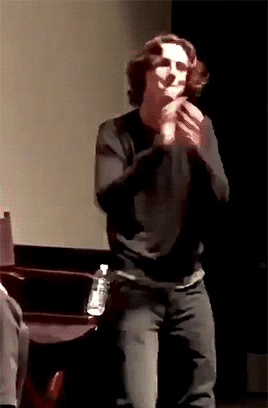
My method is messy and untrained. I don’t claim to have any secrets. My knowledge of writing is mediocre at best. But I’m having fun. And that’s were the real magic of any character comes in. Fun. Because if you aren’t writing about something that sparks your soul- either with love, happiness, hatred, etc- then it’s nothing more than a forced, hollow husk. Writing is meant to evoke emotion. At least in mind. And want to express complex emotions and share them. In a perfect world? My characters -any of my characters- resonates with someone. They become the escape someone needed. That’s the ultimate goal.
It’s thanks to all of you that Max and Auggie have come this far. It’s from their interactions with others that they’ve managed to evolve into something incredible- especially Augustine. He just kept shining brighter and brighter until I felt obligated to make him an in-game character. So, you all are just as much a part in the creative process as me. Thank you!
And a special thanks to my boyfriend for always being a sound board for my rambling ass <3
THANK YOU FOR THE ASK, ANON! Sorry I posted an essay...<3
14 notes
·
View notes
Link
Interview: Louis Tomlinson Opens Up About ‘Walls’ & Tour Plans
It’s go time for Louis Tomlinson. After years of building anticipation, the 28-year-old unveils his debut solo album Walls today (January 31). And the 12-song collection (featuring familiar titles like “Two Of Us” and “Kill My Mind”) was well-worth the wait. On it, he reintroduces himself to fans after taking over the world as one-fifth of One Direction. And the crooner does so by placing the focus on his powerful pen to provide a glimpse into his heart and soul. Whether he is overcoming seemingly insurmountable obstacles on the title track or embracing a youthful sense of adventure on “Fearless,” every song offers a chance to engage with him on a new level.
But dropping Walls was just a warm-up. Now he turns his attention to the accompanying world tour. It all starts with a March 9 set in Barcelona. Then the hitmaker spends the next several months making stops across the globe. That includes a string of North American dates in June and July. And it’s the moment he’s been waiting for. Last week I had the opportunity to chat with Louis about the rest of his action-packed 2020. He opened up about how he mentally prepared for the arrival of the album and his goals. After that he spilled some tea about the show. That includes a little insight into the setlist selection process.
OG fans will be happy to know that they’ll definitely hear a couple One Direction staples in a live setting again this year. Even better, Louis plans to play every song off Walls. Keep an eye peeled for our official album review in the coming days. In the meantime, dive into our interview below to learn more.
You’ve been working towards Walls for a couple years now. How does it feel to be so close to releasing it?
I think just a big sense of relief. I’m excited to release it and to have the fans hear it. And to go out there and tour it. So I’m just excited to get into this stage. It feels like it’s been a long time coming.
Obviously you’ve done a couple album releases before, but it was always as part of One Direction. Do you feel like this being a solo project changes your perception at all?
Yeah, I think there was a slightly different goal. Naturally with the One Direction albums versus with my own solo album. I think I actually kind of review once I’d come out of the band… I had to almost redefine the word success really. Because the experience I had in One Direction wasn’t really real life. So in terms of what I want to get out of this album and what I’ve for starters learned a lot along the premises. But what I want to get out of it is that hopefully my fans think I’m a good songwriter. So really it’s almost less pressure in a way.
I think lyrically your writing is coming across so well.
Thank you.
Speaking of the songs you’ve released, it’s interesting looking at the tracklist. Some of the songs made the final cut, but there are a couple older singles that didn’t. How did you decide what would live as a stand-alone moment in time versus what would make the final album?
I think when I looked at the older singles that I’d done it was hard sonically for them to sit on the album. On the vinyl I did a version of the Steve Aoki song “Just Hold On.” But it’s a completely new production. We reworked that. But with the other singles, it was kind of difficult to imagine them on that record. I feel like my songwriting kind of matured a little bit since then.
Can you talk about why you settled on Walls as the overarching title for the album?
To be honest it’s my favorite song on the album. I think it’s the best song on the album. It’s the song I’m most proud of. So I’d been thinking about what title I was going to have for the album for a while. And then I kind of just thought let’s not overthink it. What’s my favorite song? I love the concept behind the single so I kind of just went with my gut and went with that.
It’s interesting too because as I’m listening to the album I notice that you obviously reference walls in the title track. But you also talk about fences on “Defenseless.” It seems like there was a theme emerging of overcoming barriers or putting yourself out there without barriers. Was that intentional that you were doing lyrically while writing?
Not deliberately but I do try to write in an autobiographical sense. And as relatable as possible. I think that’s one of the things that we all go through at times. So I felt like yeah it was important to cover that. I hadn’t realized. A lot of walls and fences.
A lot of things we had to get over. Looking at the tracklist, is there a song that hasn’t been released yet that you’re most excited for fans to hear?
I’d say “Only The Brave,” which is the last song. It’s just short of two minutes long, and it doesn’t really have a traditional structure to the song. You only really get the chorus once. And I think it’s an interesting moment in the album. It closes the album, and I think it’s interesting.
One of my favorites is “Fearless.” I love the message. I took it as encouraging yourself to return to our youthful confidence and just saying fuck it to expectations and anxiety.
Yeah, absolutely.
I was hoping you could tell me a bit about how it came together?
I think the age that I’m at at the moment, I’m 28 now. I’m kind of in this strange age. We’ve got a bit more life experience, but it’s kind of reflecting on how fearless you are when you’re young. The fact that you are willing to make mistakes over and over again. It’s just drawing on that whole vibe, really.
That’s something I relate to being at a similar point in my life.
Nice. I appreciate that.
Do you plan to release any more singles off the project?
No I don’t think so. I think I’m going to release the album, and I’m going to get into tour and just concentrate on that for a little bit. Just so I have more stuff to write about. Then at some point this year I’ll get into writing the next record I suppose.
Awesome! It’s good to hear that there are already plans for another album.
Yeah. Definitely.
Something else I wanted to ask about was the “Walls” video. Some of the other videos this era have been more straightforward in terms of a plot, whereas this felt more conceptual. How did you come up with the idea for this one and what does it mean to you?
This is the fourth video that I’ve done with that director Charlie Lightening who’s amazing. I really enjoyed working with him. The first three videos fit together. Were narrative driven and had a bit more story to them. So I thought, we both thought it was important with this video to kind of move away from that and make something visually more interesting. We went to Morocco to film it in the desert. I Think it looks incredible. You’ve got that scale with it being in the desert. And yeah, we were just trying to make it look kind of trippy and surreal. Visually interesting. Just a good sort of performance video instead of getting lost in a narrative.
Cool. I also wanted to talk about touring. How are you getting ready for the show?
I’ve been doing little bits of rehearsals here and there because I’ve got TV performances anyway. Like two or three weeks of rehearsals. To be honest since the year started I’ve kind of been counting down the days in terms of my solo career. This is what I’ve been working towards. So I’m really excited about it.
It brings everything together, and it’s great to see that this is coming. I was reading your last interview with us and you mentioned that touring was a big goal. So it’s great to have it be here.
Definitely. It feels good.
Speaking about the show, will the focus of the setlist be on your solo music or do you plan on throwing in any of the material you wrote for One Direction?
I think it’ll be like there might be three One Direction songs in there. I mean I’ll definitely put a few in. It would be rude not to, and there are some bangers in there. But mostly Walls. I’ll probably do the whole album and maybe two or three One Direction tunes.
That’s awesome. I can’t wait to see what the setlist ends up being. Thank you so much and good luck with everything you have going on.
Thank you very much. I appreciate your time, man.
75 notes
·
View notes
Note
I was just wondering if you had any advice for a new writer? More on how to approach writing a book or anything you wish someone had told you, thanks!

THE BASICS OF NOVEL WRITING
First off, you have to know these two things:
Your first draft of your first book will be terrible.
All your favorite authors of all time wrote a terrible first draft of their first book too. Probably a terrible second and third draft, maybe even a terrible second and third book.
This is okay. It can make writing hard sometimes, but the point of writing is not to whip out a masterpiece the first time you type: it’s to have fun exploring new settings, watching new characters grow, and being the first person to ever experience this story–your story–progress!
So, where do we begin?
Know thine story.(or ya know… to don’t.)
Before you tackle any kind of project that will take months, even years, of work you want to first decide what you’re actually doing. In the case of writing, we outline. (Or sometimes, we deliberately choose not to online, but only after we thought about outlining and maybe tried it out a little.)
There’s no wrong way to outline. Every writer does it differently, and therefore there’s about a million different methods. You can instantly find a ton of them using google, and these are a bunch of my own personal outlining tips.
The things you should know by the end of your outline include:
Setting. Where does your story take place? What does this place feel like? (If it were being filmed as a movie, what would the color palate look like?)
Worldbuilding. If you’re using a real place, how much research have you done? If you’re creating the setting from scratch, in which ways is it like our real world and in which ways is it not? (You don’t need to know everything about your world building going into a project, but it’s good to keep track of what you haven’t figured out yet, so you don’t get to the end of the rough draft and realize that everything you made up along the way contradicts itself.)
Main Characters. Who are they and what do they want? What beliefs or flaws are keeping them from getting what they want, or driving them to want something which hurts them? What’s the first trait someone notices about them? (Check out this nifty character creation sheet for some simple development questions!)
Plot. Now, plot sounds scary to a lot of writers, but a plot is just the accumulation of your other story aspects put at odds with each other. Your characters will make choices trying to get what they want, and those choices will effect the rest of the world, which in turn comes to bite the characters in the butt and force them to make more choices until eventually they get what they want, for better or worse. That’s the basis of a plot: it’s everything standing between your character and the rest of their life. (If you don’t have any semblance of a plot, check out these nifty tricks.)
Genre. Specifically, why are you telling this story in the genre you chose? How do the themes and tropes of the genre work with your story? What would the story look like in another genre?
Optional: The Beginning. If you come to the blank page of death without knowing exactly where you’re starting it can be incredibly daunting. Check out my tips on writing the first act for more help.
However you chose to outline, (and whether you chose to outline at all), the most important thing to know going into a story is what will produce the central conflicts?
Conflict drives a story.
Conflict between characters and other characters.
Conflict between characters and the obstacles to their desires.
Conflict between characters and their own flaws and beliefs.
Even if you have no idea where your story will go or how it will end, as long as you start out your story with a conflict that’s difficult to resolve, you’ll always be on the right track!
Now, to the writing.
For the first draft of your first book, I’m going to suggest this controversial tip: Ignore all the writing advice.
The learning stage of your writing journey (aka the first three books you write) will be a mess of picking up and throwing out advice, and you’ll have plenty of time to do that once you start revising your rough draft, but for now the most important thing is finishing your first novel.
Write your story exactly how you want to and damn the advice.
Some important things to do though:
Decide how many words or pages you want to write a week and try to continuously hit that. (But start out small! Your writing heroes might be churning out a novel in a month, but a thousand words a week can be an good and ambitious goal during your first novel!) The key is to build a habit.
Find someone to motivate you! This can be another writer friend but it can also be a non-writer friend you’re comfortable talking about your writing with. Tell this person what you’re doing and how much work you want to put in each week and let them be your cheerleader.
Don’t get feedback yet. If you do have a writer friend cheering you on, it might be temping to send them your work asking for their opinion, but negative feedback tends to demotivate and make you question yourself. If you’re letting people read your first rough drafts, ask them just to be motivational right now, and then save their critique for when you’re ready to edit!
Don’t even get feedback from yourself. It’s very tempting to stop every three paragraphs and wonder if you could have written them better a different way. And the truth is, you probably could, BUT imagine how much better future writer you (who has finished the whole manuscript and has far more skill than current you) will fix those paragraphs up?! Current you has barely any more skill than the you who wrote those paragraphs last week, so let your future far more skilled self handle it.
Don’t be afraid to change your story and process as you go. If you go into your story believing something specific about it, but you come up with something you like better as you write, you’re allowed to change it. You’re allowed to write it out of order. You’re also allowed to write another story beside (or instead of) the one you set out to write.
Above all: KEEP WRITING. Writing can be tough (even for the best and most skilled of writers) when you stop writing and start thinking, because thinking often leads to doubting and fearing. Just put one word after the next and let your future self worry about whether those words sound good together.
You can find more of my advice about the rough drafting stage here!
So, you have a novel... now what?
Now comes the revision stage. (And yes, you will have to revise. Some writers have to do more revisions than others, but nearly every author worth their salt will have at done at least three drafts of a story before sending it out into the world.)
Just like outlining, there are many ways of revising and each writer has to do what works best for them. Some people rewrite the entire book from scratch. Some take elaborate notes and then rework pieces at a time. Some just dive in and change whatever they don’t like as they read. Here’s an in-depth look at what I do when I edit my rough drafts.
For your first novel, I’d suggest one of two ways:
Rewrite it all. This is a good method if you either changed your story a lot while your wrote or you didn’t have a thorough outline so your resulting story ended up having huge holes. Rewriting is never a waste. Your pacing, dialog, even your prose, will all come out better when you rewrite the same story over.
Re-outline it all. This is a good method if you don’t think you need to rewrite but you don’t know where to begin editing. Read through the story and track everything that happens and then compare it to standard character arcs, three act structures, and so forth. The goal is to figure out how your story compares to the ideal simplistic stories in your genre and then tweak your story to make it closer to the ideal.*
*In no way do you have to stick with traditional or simplistic structures for all your writing, but if you don’t know how and why the traditions work, it’s very hard to produce a great story that defies them.
Once you’ve done some editing yourself, you want to find another writer (or three, or five) who’s of a similar skill set as you and get their feedback. They’ll be able to pick out issues you didn’t notice.
The final thing you’ll have to deal with in the editing process is your prose. Most writers have terrible prose for the first 50k to 100k words they write. Beginning writers who’ve already written short stories or role played or wrote a lot as youngsters tend to have an advantage in this. The thing to always keep in mind is that it’s okay if your first book’s prose is awful.
You’ll have improved your prose just by writing it, and you’ll have a better grasp on story as well. This book doesn’t define who you are as a writer. If you really love the story, you can chose to rework it further to clean it up, or you can use what you learned through it to write another book that’s cleaner from the get-go.
THINGS I WISH I’D KNOWN STARTING OUT
1. First books almost never get published.
A lot of us resist this, because our first books are good, dammit, we worked very hard to make them that way! But the quality of the book isn’t always the thing that holds it back; often the first book we write ends up pretty similar to the more poorly written published fiction, but it wasn’t written with knowledge of the publishing industry and the market.
And that’s okay! It’s okay to write a lovely book that you put aside so you can publish your second or third or fourth book instead. That first story is still wonderful and it still helped you immensely.
2. Not everyone will like even the best story you ever write. (And even if it’s a literary masterpiece some of them will quote literary flaws as the reason they don’t like it!)
It’s common knowledge that everyone has different tastes in literature and one person might dislike a story another person loves. What’s talked about less often, is that the people who dislike a story based on taste, will often pinpoint specific literary aspects they believe were done poorly. They’ll say the characters are bad, and the plot had too many holes, or the prose was clunky. And they’ll probably believe what they say, and find evidence to back it up.
And that’s okay! As long as the majority of your target audience isn’t finding these things a problem, then you’re in the clear as a writer. Not every reader’s critique is valid and not every piece of feedback is worth listening to, even if it has the lingo of a legit critique.
3. You have to be reading in order to write well. Or, more specifically: If you aren’t reading books, you won’t write as well as you can.
It’s easy to assume that just because we read a lot of books growing up and know how stories work that we can write good ones. And in some ways, that can be true. We can write good stories without reading good stories—but we can’t write great ones.
A writer who really wants to improve their craft should try to read a book a month, or more if possible. If you have limited time, you can read shorter books, listen to audiobooks, or quit any book that doesn’t immediately hold your interest. But do read. Read, read, read, read.
4. If you can’t write a blurb, the problem is in your story.
Maybe this is a little harsh; there’s a lot of skill required to writing blurbs and it does take practice! But whether you have a concise story with characters whose goals and resulting conflicts weave seamlessly into the setting and create an easily describable plot with specific, emotional stakes and hard character choices will be very clear when it comes time to write those down as a 200 word blurb.
It’s so essential to blurb writing to have a tense, well paced, nicely woven story, that writing the blurb while you work on the story’s rough draft can actually help you produce a better story!
5. Sometimes the best stories are not the epic masterpieces but the ones you’d want to whiz through despite its many flaws.
And these stories are worth writing. Don’t feel the least bit bad for choosing to write the book you’d want to read as a ‘guilty pleasure.’
And on that note, if you’re still reading this, go check out my guilty pleasure book Our Bloody Pearl to support my ability to answer asks (and also get a swell read about a sassy, disabled siren and a soft, freckly pirate.)
#writeblr#writing help#writing advice#writing resources#writing tips#writers on tumblr#authors on tumblr#writers on writing#how to write#creative writing#thedaysidontremember#writing tag: method#method tag: writing#scheduled post
1K notes
·
View notes
Text
SAGE 2020: The Usual Suspects

Hi, folks! Back when I used to work at TSSZ a lot of people really enjoyed reading my articles where I’d talk about various games at the Sonic Amateur Games Expo (SAGE), and I’ve gotten more requests in the last month and a half to continue doing those types of articles than I think I’ve ever gotten about anything else I’ve ever done before. So, here we are!
But I also need to be real with you: there are a lot of games at SAGE. It was exhausting enough when there were 70, 80, or even 90 games. Heck, the one year I wrote about 85-something games by myself, I sort of felt like I was going to die. This year, there are over 220 games at SAGE. It is physically and emotionally impossible for me to talk about everything, and it may even be impossible for me to play everything. Things will fall through the cracks. Most things, probably. Though I am responsible for basically inventing SAGE 20 years ago, I am also a human. I have my limits, and I am sorry it has to be this way.
Structurally, we’re going to be doing things a little bit differently, and you should expect this to be a little fast and loose. Since I’m not talking about every single game on the show floor, articles are going to be broken up into types:
“Usual Suspects” will be for games that either appeared at previous SAGEs or that I’m at least aware of.
“Fan Games” should be obvious, and it’s whatever doesn’t fall under Usual Suspects.
“Indies” is the same deal, but for original games.
And finally, there will be a “Honorable Mentions” article for whatever random leftovers I don’t cover in the first three articles. Looking forward to me talking about your game, but I don’t mention it? Tell me about it and maybe it’ll end up here.
Without any more delay, let’s talk about those Usual Suspects...
Sonic GT
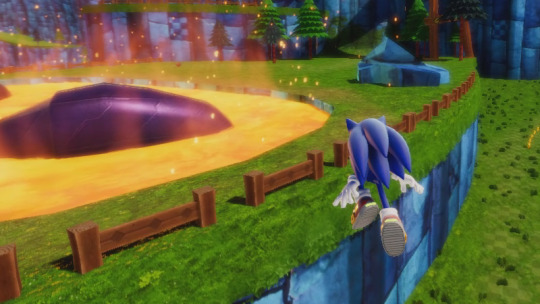
Sonic GT has always been kind of a difficult game to control, but usually it just took a little bit of getting used to. There was always a period of adjustment, where you had to learn the game’s quirks. But, over time, I feel like the game is also just getting… quirkier. Every time I come back to this, I slam head first into the Sonic GT’s learning curve, and it always feels just a little bit steeper. This is one of those games that tries to fit a lot of abilities into a tiny amount of buttons. It works, but it feels like you have to memorize an operator’s manual. It’s all about figuring out which button to hold when to get what state. But, man… when it clicks into place, it’s still kind of magic. And, at the very least, the levels have all been reworked to take better advantage of Sonic’s high-flying, death-defying acrobatics. You’ve just got to be willing to learn. The real downside of this new version is the inclusion of a proper story mode -- I don’t have anything against having cutscenes in your game or whatever, but for the purposes of reviewing these games, some ability to fast forward through the talking heads so I could get back to the gameplay would’ve been nice. You can skip ahead in cutscenes you’ve already watched, but that doesn’t help when it’s your first time through. Oh well. So it goes. (Update: in the process of getting this article posted, Sonic GT has been patched to make cutscenes always skippable.)
Project SXU (Sonic X-treme Unity)
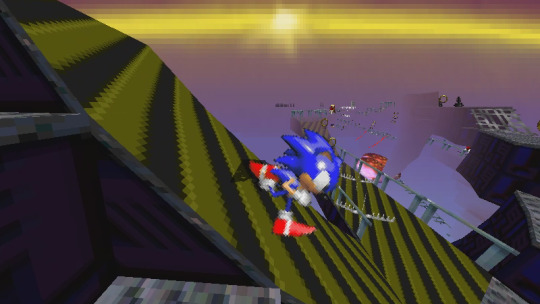
Another year, another Sonic X-treme recreation. This one’s interesting because it seems to be the most “complete” yet, offering the four most famous levels: Jade Gully, Crystal Frost, Red Sands and Death Egg. Intentionally or unintentionally, this also seems to replicate quite a few quirks we’ve seen in Sonic X-treme’s controls in the videos that have been released of the in-development build. Which means that it, uh, kind of sucks to play. I realize that’s kind of rude, but I’m sort of allowed to say that. 15 years ago, I was basically the only person on the internet that cared what happened to Sonic X-treme, so... I started contacting developers, starting with the game's producer, Mike Wallis. He lead us to Chris Senn, and that broke the dam on information about this game. Now, I don’t claim ownership over everything that came out of this, I’m simply saying I was the one who got the ball rolling. I watched the mystery of Sonic X-treme slowly get uncovered with as much intent as one could possibly have. It is a fascinating piece of lost media, but as a game… well, I think it got canceled for a reason. SXU shows us a clear vision of that, with a game that’s disorienting to look at and hard to control. Heck, if you’re using a controller, you can’t even use the analog stick -- you have to use a d-pad, leading to controls that feel frustratingly twitchy. But that's true to the experience. I probably spent almost as long in this demo accidentally slipping into bottomless pits as I did exploring its levels. Again, this more or less feels accurate to what we’ve seen in videos, though I do think Sonic probably feels a little too sensitive, here. Regardless, it’s still absolutely fascinating.
“Sonic Infinity Engine” Games
I’m cheating a little bit, here. This is technically three entries, but it’s in “Usual Suspects” because there’s been Infinity Engine games at SAGE for a few years now. Listen, it’s my site, my rules, and we’re playing fast and loose, baby!
Adventure Pack 2
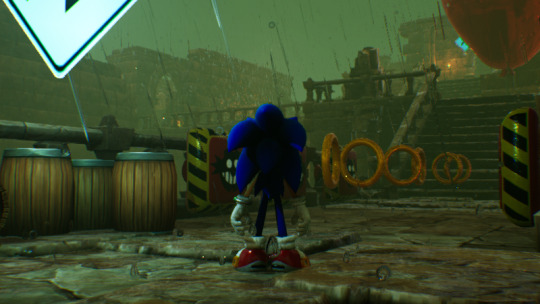
This claims to be a “pack” of multiple levels, but the one level I played went on for over 25 minutes without showing any signs of ending. The level is… well, it’s the kind of stuff we’ve seen at SAGE for years and years and years, a space previously occupied by SonicGDK and BlitzSonic before it, where somebody is clearly starting out learning 3D level design, has some prefab assets, and goes to town creating a huge, intricate environment… that doesn’t fit a Sonic game at all. Too many tight spaces, too much enemy spam, and too much labyrinthine pacing. This is “Sonic Visits Anor Londo,” and while it looks interesting visually, it’s easy to get lost, or worse, killed because something isn’t functioning right. Like a lot of Infinity Engine stuff, it’s a bit hit or miss.... And now, also cramped.
Infinity+ Colorful Combat
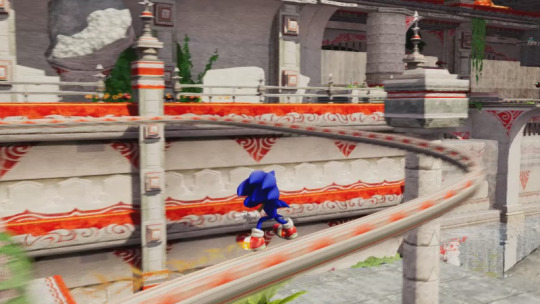
The primary goal of this seems to be to update the Infinity Engine with extra features, something that I think is pretty welcome. The Infinity Engine is okay, but it’s missing a little bit of polish that the original developer neglected to give it before abandoning the project. This helps tighten some of that stuff up, while also introducing Wisp powers and more playable characters. Some of the new characters could still use some work, yet, but given the project is still in active development, that’s pretty much a guarantee. This could end up being the defacto version of the Sonic Infinity Engine.
Sonic Reforge: Red Ridge (Blockout)

This is what’s called a “Grey Box.” Rather than build out a fully-detailed level, you get a rough estimate on how the stage will flow before you put all the graphics in. What’s here is okay, I guess, but the level loops back on itself in ways that can be kind of confusing. There are a few places where it’s not really clear where you’re supposed to go next, and I spent several minutes running in circles. I’m also not a huge fan of the changes to Infinity’s physics; jumping off of ramps is a key part of the Sonic experience, but there are several places here where that doesn’t work -- to get the height needed to progress, you just need to roll really fast. It works, but it doesn’t feel like the Sonic I’m familiar with.
Sonic World DX

I have a bit of history with this game. Or, well, with a different version of this game. I wasn’t kind to some of the original entries at SAGE many years ago, but over time, they’ve cleaned the game up and streamlined it a fair amount. Now we have the “DX” release, a further cleanup effort splintered off from the main project, but to be honest, I’m not entirely sure what’s different from the previous release. The main version of Sonic World supports an absolutely gargantuan amount of content, with 50 playable characters and at least that many levels. It was big, and weird, and impressive. This demo ships with three or four playable characters and eight stages. Beyond that, there’s not much else to say -- it’s still Sonic World, though this release doesn’t work right with my controller. It picks up the controller binds from the main version of Sonic World, correctly assuming I’m using a DualShock 4, but none of the buttons are correct. When it asks me to press the X button, I have to press Circle for it to properly register. Not only that, but the right stick camera control is completely broken. Switching to an Xbox controller fixes the camera issues, but now the face buttons have the opposite problem: when it asks me to press A to jump, I have to press X. Throws my whole vibe off, like wearing your shoes on the wrong feet. The menus are bizarre, too -- while adjusting the volume, you can’t push left or right to adjust the levels, you have to use controller face buttons for some reason. This whole thing feels like I stepped back in time to 2013 in a bad way.
Sonic Freedom
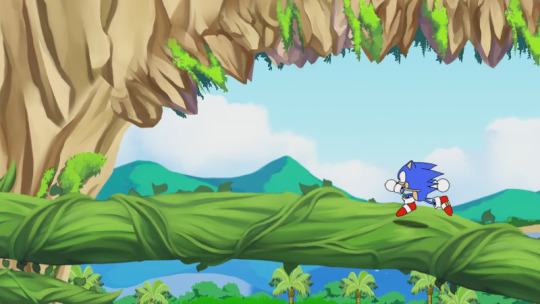
I feel like I’ve been waiting to see a major development from Sonic Freedom for half a decade at this point. The art considerations for this game are no joke, and I do not envy anyone trying to make a proper high-def 2D Sonic game that looks this good. But, well… it’s another year, and there’s not a lot here. It plays fine, I guess -- the controls are decent, at least. The problem is the level design. Does this level even end? I’m not sure. I know previous demos for Sonic Freedom have had more than one level, but the stage you start out in here is a confusing, empty labyrinth with respawning enemies and a finite number of rings. You climb up and up and up, but eventually I reached what felt like a dead end. Visually it will always look incredible, but I’m wondering if it’ll ever actually become a game at any point in the future.
BraSonic 20XX

Here’s a strange blast from the past I wasn’t expecting. BraSonic is an old fangame from probably more than a decade and a half ago. It was so long ago that I can’t even actually remember if I played the old version of the game or not, but I definitely remember the name. What really throws me for a loop playing the 20XX version now is how much it feels like a game from back in the early 2000’s. The artwork, the sound effects, the locations, all of it makes me feel like I’m 19 again. Thankfully, this doesn’t play like a fangame from 2004; physics seem pretty solid, level design flows pretty well, and it generally seems to be fun, weird, and most importantly, unique. There aren’t many fan games here at SAGE that open with their first boss fight being against Sonic the Hedgehog. If you find yourself getting burnt out from so many Sonic fan games feeling same-y, this could be a good change of pace.
Sonic Frenzy Adventure

Maybe it’s the fact that this is the 20th Anniversary of the Sonic Amateur Games Expo, but here’s another very old fangame coming back out of the woodwork for an enhanced modern re-release. This game was a mainstay of the mid-to-late 2000’s SAGE events, after which it disappeared before being finished. Well, maybe it was finished. Again, a lot of this stuff was so, so, so long ago that this poor old man’s memory just can’t recall it. Seeing Frenzy Adventure back warms my heart, though. It’s an old friend in what has proven to be a very challenging year. Admittedly, parts of it still feel a bit mid-2000’s, but I consider those charming quirks. Throwbacks to a simpler era. At the very least, controls have been improved, so it does play better than the old releases did. Good stuff. Glad to see you again, dude.
Sonic Speed Course
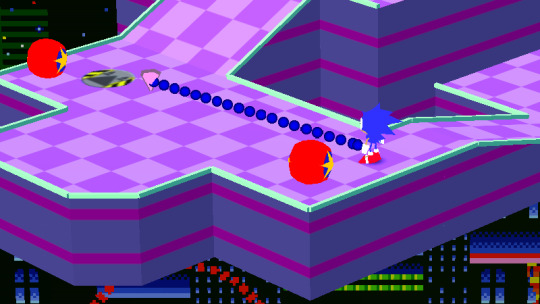
This was a game that turned up last year, but in the kerfuffle I didn’t get around to trying it, even though I really wanted to. This is clearly a game inspired by Kirby’s Dream Course, but instead of Nintendo’s pink puffball, we have Sonic and friends. Whereas Kirby gained abilities by bowling through enemies, this adapts a more traditional Sonic gameplay structure of item boxes filled with shields and other powerups. But here’s my deep dark secret: even though I love Kirby’s Dream Course in concept, there’s a part of me that feels an intense hatred for that game. I have distinct memories of renting Kirby’s Dream Course as a kid and getting really far into the game, but trying to play it as an adult I’m baffled at how difficult it is. The main problem I have is that every stroke you take subtracts from your health, meaning you can only hit the ball so many times before you just… die. This makes for a very, very steep learning curve that discourages play and experimentation. Every shot truly, deeply matters and eventually I find myself caught in a death spiral and staring at the game over screen. All of this is replicated in Sonic’s Speed Course, which, much like with Kirby, I find myself drawn to like a moth to the flame -- only to come away feeling dejected and like I’m just not good enough. For fans of Kirby’s Dream Course, this is undoubtedly good news, as this means Sonic Speed Course is faithful to the tone of that game. But I find myself wishing there was a practice mode or something that let me play these courses without the punitive health system, because I’m ready to love them.
Sonic: Triple Trouble 16-Bit
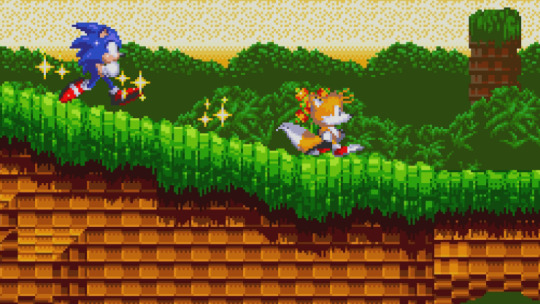
When you write about so many games at SAGE every year, things start to blur together... a lot. I seem to recall that Triple Trouble 16-Bit last year was good, but had room for improvement. Well, this year, this demo feels… really quite good. I’ll admit, I was a little skeptical about remaking this game. Sonic: Triple Trouble was among the first batch of Game Gear games I ever owned as a kid, and while I liked the game, in my adulthood, I feel like I’ve come to appreciate Sonic Chaos more. But so much has been added to this game that it’s really come into its own. It uses Triple Trouble more as a jumping off point to become something fresh and interesting, and on top of that, this demo is pretty polished. This game was kind of always on my radar, but it’s really turning into something special.
Battle Cross Fever
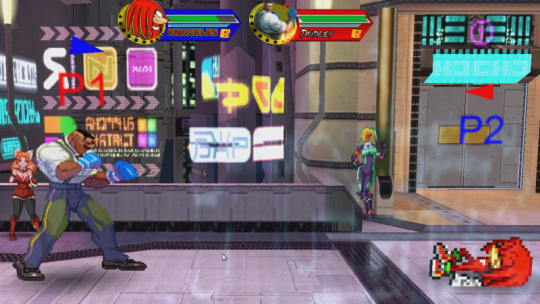
Every year, I download this game hoping for some kind of single player offering, and every year I’m let down. Battle Cross Fever is a fighting game that plays a lot like Smash Bros., but contains elements that pull it closer to traditional fighting games like Street Fighter. It’s the kind of game that can check with the server to make sure you’re playing the latest version, but doesn’t have true online multiplayer -- instead advertising that you should use a piece of screen sharing software like Parsec to accomplish online multiplayer. In their defense, the few times I’ve used Parsec, it’s basically been magic for how well it works. But I just want, like… anything that I can play by myself. Even if it’s just a super basic arcade mode with brain dead AI, anything is better than nothing. But, I suppose, I am an outlier. Judging by the horrific character select music I landed on, Battle Cross Fever has enough of a community that they could get fans to sing along to “Ghost Town” from Sonic Forces -- which is a fun idea, don’t get me wrong, but when you have loud voices over cheap microphones, well… I hope you aren’t wearing headphones like I was. Anyway, this game’s always seemed solid, but I’ve also never played it with another human being, so really, I’m speaking from the perspective of admiring the diverse roster and all of the fun arenas they’ve ported in. Maybe someday it’ll get some single player content.
I’ll be back with another article… uh, eventually. In truth, I was only going to feature five games here, but it ended up being ten, so we’ll see how many are in future articles when we get there!
#writing#SAGE#sonic amateur games expo#review slew#sonic gt#project sxu#sonic infinity engine#sonic world#sonic freedom#brasonic#sonic frenzy adventure#sonic speed course#sonic triple trouble#battle cross fever#review
8 notes
·
View notes
Text
Initially, I wasn’t overly sure how to interpret our title of ‘black books and black holes’. I’ve felt awfully low for a while, and it’s been heavy on my mind, so I figured I’d take this project as somewhat of an opportunity to reflect on the past, troubles i’ve had as well as using it as a kind of venting of current frustrations. These low points act as my own personal black hole, as I fall down into them for some time. Similarly to how black does, they absorb any kind of light surrounding. To me, at times, this has meant not enjoying things I’ve adored prior - such as spending time with loved ones, music and hobbies. Growing up there were several black holes, but amongst them I have fond memories with my cousins, siblings and childhood friends. Somebody who has always been there for me (whether it be through choice or not) has been my brother. I decided to incorporate pictures of us throughout my little black book as homage to him as he is truly one of my favourite people ever, despite the troubles I don’t think our bond has ever gone away - it’s merely taken small redirections. I have such admiration for him and know I can rely on him and speak free from judgement. Years ago, I believe it was 2013, he fell ill and this meant he had to be hospitalised for a couple months. It was really hard for my family and was of course even more difficult for him. Seeing as he was hospitalised, this meant regular trips to the hospital, on the car journeys we’d always have the same Passenger CD playing in the car. I guess we just never got around to changing it. On this CD was a particular song that we’d all sing along to, which funnily enough is called ‘holes’. Hearing this song now makes me feel so safe and hopeful, knowing it got me as well as my family through a rough period in time. I made sure to incorporate some of the lyrics into one of my book spreads. One line reads, ‘but we carry on’, which has definitely stuck with me.
The constellation element of our project had me reflecting on space and the universe, and what exactly it means to me. Although I’m not too into space, I’m definitely fond of the moon. After my parents divorced, I was left in custody of my mum for a while. A teacher told me to look at the moon, because she’d be looking at it too at the same time and thinking of me. During this time I was living in a troubled home (I made this house the exterior of my book*) and would be heavily supported by her in school. She’d give me notebooks to express myself in and explain what was happening, as well as a departing gift when I inevitably left to go live with my dad here in Bury. Despite being a small part of my life, she still means a lot to me and has a place in my heart. Though not physically present with me anymore, she cared enough to find me years later and reached out to make sure I'm doing fine. It's reassuring knowing there are people as pure as she is. Because of this I dedicated a small section of my book to her that looks like a slither of the moon when the pages are flipped back onto it.
My black book was titled ‘Wailing Ghosts’ by Pu Songling, containing 14 tales of various monsters and creatures, which is fitting to my work revolving around numerous burdens I have that seem to act as these little monsters also, creeping up every now and again. I did consider creating my own ‘chapters’, one for each black hole of mine, but didn’t want to structure my book in that way as I didn’t want to disrupt my creativity or force things.
I say ‘was’ because I actually decided I wasn’t all that keen on how i’d layed my pages out. I instead took a second black book and collaged, reworked and inserted pages into a new one. I’m really glad I did so, as I now have a book I much prefer over the first. An aspect I did keep relatively whole was the swirly, illusion-looking front cover with a hole burned through the centre, almost like a little entrance to another world. Stanley Donwood inspired this page through his swirly seas he often features in his works, as he uses a bold thick line against white ones. I opted to put this page underneath my front cover so it still got to be showcased - only cutting a part off the corners to make sure it fit.
Featured in my book are a few small self portraits, in varying cartoon-y styles. Some are only inspired by my face whilst others were drawn whilst staring into the mirror, then back at the page. Having struggled with low self esteem, there have been times where I don’t even want to perceive myself let alone interpret that into a drawing. Meanwhile doing my book work, I realised I have never drawn a self portrait - not since being a kid anyway - and had even actively avoided doing so during GCSE art. Over the past year or so, I’ve overcome an array of issues I’d had, so found myself able to draw these little portraits. It sounds pretty insane to me now that I would’ve found it so hard before, knowing I enjoyed coming up with various ways to put me in my book, even wanting to print pictures of me (sadly our printers decided to act up so I was not able to implement these). I feature my bathroom mirror on one page as it’s been the target of over-analyzing and although I have come far in self love, it still remains a deadly weapon.
Claude Heath’s sketchy, rough portraits inspired me to create my own. I really enjoy how reckless his style is, as I'm trying to escape the ‘this has to be perfect’ mentality, Heath is a great example of how you don’t need to overthink your work. It can just exist and look cool. It’s fine. This was also encouraged in Thursday drawing sessions where we did blind drawings. I kept this mindset whilst doing my book as I tend to either overwork myself trying to create ‘perfect’ or do absolutely nothing, so I went with the flow of how my book panned out.
Seeing as my work theme is a little on the darker side, I considered subduing the colours or perhaps even going full black and white. However, I love utilising colour in my art and felt this would make me feel unmotivated and uninspired. Especially seeing as this book is about me, it’s not insensitive to anybody to make it colorful and exciting. So, I have. Plus, despite everything I’m still smiling so I wanted to convey that somehow. Sort of, making the best out of bad situations. Damien Hirst’s usage of colours influenced me to just have fun with it, in the same way he does when creating his works.
Throughout my book I have experimented with oil pastel, paint, staples, collage, rorschach ink blotting, screen printing, spray paint, photocopied pictures, flip book, tracing paper, washi tape and i’m sure there’s more. Point is, I wanted to cover a wide range of techniques seeing as there were many pages. In doing so I believe this was the best way as it meant there was a flow of ideas coming as I worked. I’ve learned that I love a range of ways of working as it keeps my brain ticking, meaning the work doesn’t feel stagnant and dull. Sadly there were lots more ideas I had for what to do into my book, but due to various reasons I couldn't. Such as wanting to sew using a sewing machine into my book, I tried to set my sewing machine up but when I would go to sew the thread would snap. But I believe it’s definitely something worth trying another time, as I was intrigued to see how it’d turn out. I also wanted to make a better flip book from the corner of my little page (see animation on blog) as it’s really simplistic. But drawing the little stick men alone took me an hour or so, and I didn’t see that being of much importance compared to getting actual pages filled out. Thus, I left it as a simple stickman. That being said I think the stick man illustrates the cycle of being in a slump, which is relatable to how lockdown is feeling and fits well with my book contents. I felt inspired by an artist who goes by ‘inhalerqueen’ (Amanda) on tiktok, who draws a simple, silhouette-like figure repeatedly. She calls this figure ‘void’ and i’d consider her work to be vent art, expressing how she feels. Originally I wanted to make my stick men look like void, however I don’t think that would be all that beneficial/change the effectiveness and would only take up more time.
If I were to have a soundtrack to my work I would opt for ‘Yellow’ by Coldplay. Reason being, regardless of my state of mind I return to this song and feel the same listening through every time. It’s such a lovely song and just feels like peace, as cheesy as that may sound considering Coldplay is very much dad music. It reminds me of my yellows, and how much they mean to me. Even with the black, I have my yellows. Lyrics to the song can be found in my book also.
Overall, I’m relatively pleased with my work. There’s no doubt things I would do differently, but I’m glad I’ve had this experience and was able to vent a little similarly to how Amanda does. In future I hope to perhaps recreate this book and treat it as kind of a ‘rough’ or ‘plan’ for a more refined and thought-out version, perhaps this time with chapters like I'd considered and with ideas I didn’t get to delve into. There are pages I’m not so keen on, but I’m proud of myself for just leaving them as opposed to overworking them and/or scrapping them just because they aren’t what I like. I love the pictures of me and my brother, if I could I would’ve collaged more into my book however our printer simply wouldn’t allow it. As well as the exterior of the book, as I think it adds a personal element as opposed to being left as it was.
2 notes
·
View notes
Text
List of things I hope will happen in the Sonic Movie Sequel For some context...
After watching through the Sonic Movie (2020) several times, I’ve been getting ghosts of nightmares and daydreams regarding the sequel. I have specific, personal ideas for what I’d hope the sequel will cover since there was quite a bit of anticipation for more Sonic-esque lore and story during my third watch-through of the movie. So yeah, needless to say, this list is very much personalised, and the structure of it is pretty dense, so apologies to those who aren’t dense readers.
Oh, and surprise surprise, this’ll be long. So I’ll be hiding everything under the read more thingy. Click at your own discretion....
1) Sonic and Tails meeting (+ relationship)
I’m hoping Tails will have a significant difference regarding his character since he never grew up with Sonic, nor had any reason to look up to him. This would mean that any potential character arc for Tails will be pretty much untouched territory since most (if not all) the past takes on Tails’ first meeting with Sonic have been either underwhelming, insignificant to that continuity’s Sonic-&-Tails dynamic, or both. So I hope the movie doesn’t brush off the two’s introduction and that Tails is kept as a relatively significant character despite his not so close relationship with Sonic. I have personal fears that Sonic and Tails’ relationship will get rushed in the sequel similarly to the way the first movie rushes past 10 years of Sonic legitimately living in isolation by himself [(with little to no addressing of any experiences the kid would encounter through those years). I have some criticisms to make about the improper use of time skips in that movie, but that will be for another day.]
Anyhow, I hope the movie prioritises their relationship by NOT giving away too much screen-time to other characters, since him and Tails’ close sibling-friendship dynamic would need proper screen time to develop — this is UNLESS the movie team are planning on further deviating from the games and mainline continuities, which is a whole ‘nother can of worms...
Rewatching that ending scene, Tails lights up with hope at the thought of finding Sonic, which leads me to question whether he’s already met him or is simply elated at the success of finding him. I’m currently leaning towards the prediction that Sonic has a legend surrounding him and his speed and Tails knows him simply as that.
Thing is, will the reason he’s looking for Sonic directly endanger Sonic’s happiness and life on Earth, or will it poke at Sonic’s curiosity regarding his past and Longclaw? I feel the motive for seeking out Sonic will be the driving factor for how their relationship will develop and be executed. This set up for Tails’ introduction seems very clever to invoke some hype for Sonic fans, and give the writers themselves opportunity to put a unique take on Tails’ character — there’s potential to have his character be altered from even the modern games (which could be a good or bad, depending on how they interpret Tails’ current character, and what they think would require some reworking). I’ll address this further in the next point.
2) Tails’ Character

Tails’ current character is a mixed bag. In the games, he’s been written to be very cowardly and dependent on Sonic (Sonic Forces), a whiny asshole (Lost World), or just a lowly submissive sidekick. The comics do a better job with his character, but I do hope in the movie series he won’t end up being dubbed as ‘Sonic’s sidekick’ ever. The thought of that happening sounds pretty outlandish, maybe might even a bit insulting to the writers, since Sonic has been written as a more fleshed out character in the movie than he’s been written for quite the decade — I don’t see why or how Tails would be treated any different. But since it’s apparently pretty easy to write Tails into a pretty lame character, I’m gonna not have expectations once more till I see the final product, or interviews with whoever ends up voicing Tails.
I think in the movies, it’d work if Tails acted like a kid too (much like Sonic) but is perhaps more downplayed due to his (currently vague) responsibilities. Tails will probably still be a few years behind Sonic, so he still has that natural childlike innocence and naïveté — plus, without Sonic, I’d say he grew up to respond obediently to instructions and commands so this could be something Sonic might bump heads with. Tails could have a background lacking in familial relations, something that would be worthy of note in comparison to Sonic’s current living situation. Tails would likely also fall into being the expositionist character in the movie — which is both inevitable and acceptable on my part, as long as it won’t always be him. Also, it’d be cool if he either ends up abducting Sonic to bring him to their world, or acts as an initially polite chaperone for Sonic (and Tom, begrudgingly) — this would reinforce Tails as a character that can stand on his own without tying himself to Sonic, which is something I’ve been sorely hoping to see from his character for quite the while.
3) The Echidna Tribe, Tikal... (& Knuckles)

I’m pretty conflicted with this, since we have no info on what the sequel will be focusing on. But I figure, since the first movie went out of its way to introduce the Echidna Tribe early on — and subtly kicked off Sonic’s tragic backstory and, subsequently, the events of the first movie — they were to come back in the sequel. So what I have to say about them is... first off, they are not extinct — so we already have a major deviation from Sonic Adventure continuity, so there is almost no telling what the writers will do with em, which is both mortifying and exhilarating. Second, their motivation is at best drawn from inference — I predict that the Master Emerald exists in this story, and I predict Sonic being born with speed will be something of significance to the Echidnas (perhaps even told from a historical prophecy), but whether the Master Emerald and Sonic will be connected in any way will be hard to deduce with what little information there is. But I’m already making the bold prediction that they will play a major role in the sequel, so I’ll hold off on further speculation.
On to my Tikal paragraph... I want her to appear in this series, and I think it’d be more fitting she has more presence in this movie than Knuckles since her character directly tied into the Echidna Tribe as she was actively against their violence, so I could see her being an ally to Sonic and Tails, perhaps even being aware of Longclaw and knowing what happened to her. Tikal also just has a really cool theme from Sonic Adventure — just listen to it!
youtube
It honestly sounds like something that’d translate well into the big screen with the use of more diverse-sounding instruments, and would be fitting use of Sonic music for the fans, and for the narrative musically-speaking.
Regarding Knuckles... currently, the only thing even hinting at his appearance in the story is his natural ties to the Echidna Tribe, which I am betting (if he does appear) will most definitely be an active member in. There is so much potential for him to appear in this sequel, but the question is... how much of a role will he play? They could introduce him as a part of the Echidna Tribe, the guardian of the Master Emerald, or an isolated Echidna who isn’t closely tied to the Tribe.... honestly, there’s so much pathways to take his character.
Personally, I’d want him to actually not have a strong presence in the story (on his own at least) — more that I’d want him sticking with the group of Echidnas in the tribe. I want his character to not even be easy to pick out due to him wearing a mask. I don’t want him to stand out from his race, instead being subtly introduced as a reoccurring enemy for Sonic in the sequel (perhaps someone that actively chases after him or gets the closest to him) amongst the tribe. The best path to take with him personally is to have him be both among the tribe, but gradually exchanging dialogue with the main characters. Nothing as straightforward as him getting played by Eggman to antagonise Sonic for something he did — none a’ that. I want this movie to mostly focus on developing Sonic’s world, the Echidna Tribe and their lore, Longclaw’s character and/or history, and Sonic and Tails’ relationship. How Tom and Maddie fit into this story though, is one of the more daunting thoughts I have....
4) Tom and Maddie

Going by the fact that it’s been confirmed by James Marsden that he’s definitely gonna be reprising his role as Tom Wachowski for as many movies as desired, I’m expecting he’ll be in the sequel for a good amount of time. Whether this is gonna be good or bad for the sequel itself is up for debate, but I do see a bit of issue with him and Maddie’s inclusion in the story considering they have basically become Sonic’s surrogate parents and best friends — so I struggle to see how the sequel will successfully get into the lore of Sonic’s world without abruptly ripping apart Sonic’s happy family. Considering Tom ain’t gonna be left on Earth... if Tails brings Sonic back into their world, I can see him coming as a hesitant and apprehensive tag-along for Sonic's comfort. It’ll be hard to say if the sequel can be identified as more of a Sonic movie if Tom still accompanies Sonic into his world, but I think since Eggman is bound to return, casual audiences will still need an anchor to keep the movie from turning into just Eggman and a bunch of CGI anthropomorphic animals fighting on screen. But another issue I see here is the fact that Tom’s character in itself is rather plain in comparison to the identity of Sonic’s whole character and lore surrounding him. Tom offered normalcy, guidance, and friendship to an attention-starved, lonely, and vulnerable Sonic in the first movie. But since the sequel seems to be introducing a new variable — revelation regarding Sonic’s importance in his own world — what can Tom do aside from accompany and try to protect his hedgehog son? Tails will likely form a bond with Sonic that could rival Tom and Sonic’s budding familial-friendship, and Sonic has many other characters that can offer him friendship and love... not to mention that owl lady who “died” offscreen. The moment Sonic’s world becomes the focus of the movie, how will Tom fit seamlessly in the story? And how much of the movie will be any different from the first one? Will it still be on Earth or Sonic’s world?
Logic dictates that we’ve already seen enough of Earth, so with the introduction and set up of inter-dimensional transportation through rings, I’d figure it’d be time we focused on Sonic’s World. But given the trouble that had took place in trying to integrate Sonic into the real world (via. Sonic’s movie redesigns), I can only imagine what’ll take place in trying to migrate to Sonic’s World. Then again, it’s possible that the sequel takes place on Earth, which also sounds very likely, but less desirable to me.
Getting back on the topic of Tom and Maddie.... (yes, Ik I didn’t even bring up Maddie in that last paragraph don’t @ me)....
The issue I find I’m having with them as of writing this is the issue I found when watching Sonic X. In Sonic X, almost the exact same premise in the movie was used in the anime: Sonic characters existing in the real world. And unlike the movie, I found myself to immediately dislike the fashion in which the series wrote its human characters. To streamline my critiques regarding the anime, the human characters were bloating the cast, had very bland and unengaging personalities, and worst of all, would both serve no purpose for the overall story, and take screen time away from Sonic and his friends (who should’ve been the main focus of the story as they are the main appeal).
Applying this critique to the movie, the movie had done a fairly good job in making sure that Sonic characters and human characters had the appropriate amount of screen time, and it also justified the existence of Tom and Maddie — as they were one of a handful of notable inhabitants in the small town Green Hills, which Sonic resided in. They’re inclusion in the story was both necessary to the development of Sonic’s character, and surprisingly, Eggman’s. Tom and Sonic’s character arcs intertwined with one another. and interlocked with Eggman’s in the later half. For a rather underwhelming genre like buddy comedy, I found myself genuinely enjoying Tom’s character and felt genuine attachment to his and Sonic’s developing relationship. Which is why I’m all the more worried for how the sequel will continue on from this — since, from the look of things, Tom’s personal character journey seems to have concluded (any proceeding character arcs seem likely to pop up from Sonic instead of Tom’s own actions). So I fear I’ll inevitably lose attachment and love for the character, and in its place, misplaced frustration and irritation at his presence in the story.
So, uh... best of luck to the writers, cuz there’s gonna be a lot of juggling with the introduction of new characters and the continuation of other preexisting characters. Obviously Tom and Maddie will have to pull their weight if they’re gonna stay as prominent characters in the next Sonic Movie[(s) ?]
As unfair as this sounds, I’m not particularly excited for the next movie and am definitely worried for what’s to come for their characters.... all I can hope for is that if they come back and take up screen time, it is for good reason.
Also, I hope for more Tom and Eggman scenes. Should Agent Stone return, maybe he’ll come along for the journey into different dimensions (if there will be inter-dimensional travel prominently featured in the movie, that is...)
5) Eggman

Of all characters, I think Eggman has gone through the most interesting of changes — in regards to his backstory, character, and potential. Unlike his game counterpart, he isn’t an established to be connected to Sonic’s World, and was in fact tied to the human world. Now that he’s currently stuck in Mushroom what’s-it’s-name, there is no doubt that he’ll come out of it with his wits intact, his psyche damaged, and a newfound obsession with a certain blue hedgehog. I hope Jim Carrey can manage the comedic and genuinely threatening aspects of a man stripped of Earthly comfort and prestige, and now surrounded by foreign concepts of other worldly beings and power. I hope him becoming more acquainted with Sonic’s World will be represented with Sonic-music-turned-movie-soundtrack-appropriate music. In the end, I don’t expect Carrey to do a familiar take on Eggman of the games and previous cartoons, but I can imagine him effectively showing the effects of a year’s worth of isolation in a mushroom world on an already egocentric and eggcentric man. So I have positive thoughts for Eggman. If the sequel suddenly belly flops in quality compared to the first movie, I’ll still come for Carrey’s Eggman performance.
6) The main cast of characters for the sequel

To summarise, this is my compromise on what the main cast of characters in the sequel will be. Consisting of both the characters I want to see get focused on, and the characters likely to get focused on. For the record, I know that this is way too early to properly make any predictions about the main cast, but this is mostly tied to personal opinion, as well as deduction, so take these with a grain of salt.
Conclusion
Now, I could be way off with my speculations, but I think as of now, with little to no information about the sequel, my thoughts, desires, and worries for the sequel are justified (and of course a little much). But now that I got these out of the way, I’m hoping this will either collect dust here instead of the back of my mind, or that this could spawn more discussion in the future when more info about the sequel comes up in the seemingly far-off future of 2021.
#sonic movie sequel predictions#sonic movie#my posts#i'm thinking of organizing my posts more#but ik it's easier said than done given how sporadic i am with everything in general#i'll get better i promise#if y'all got any comments or opinions about this feel free to respond
2 notes
·
View notes